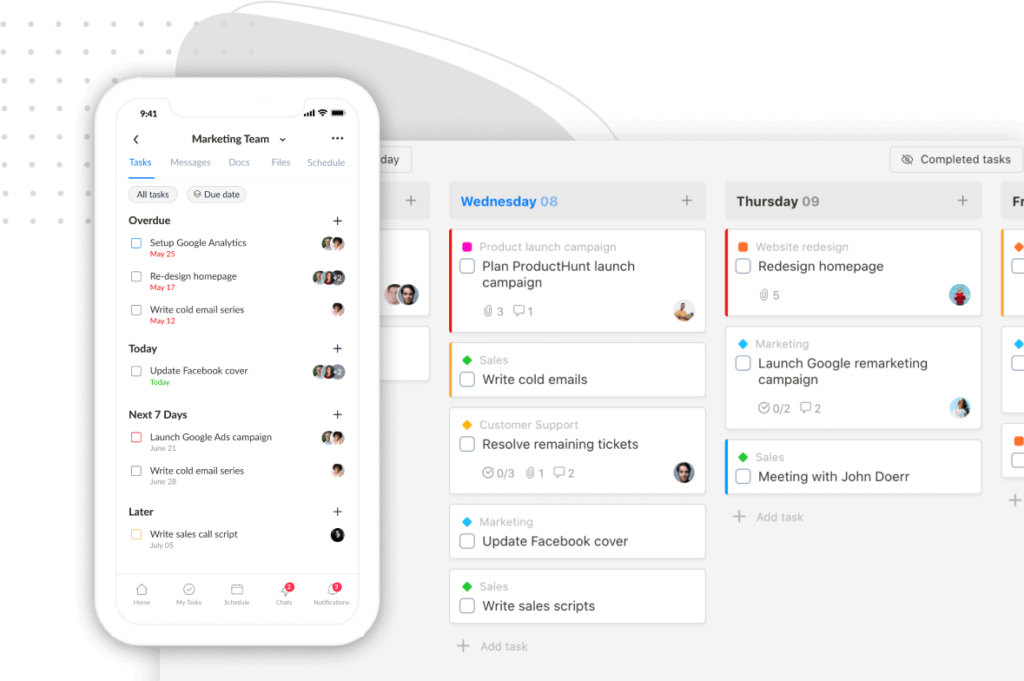It’s becoming increasingly difficult for marketing agencies to acquire clients.
That’s what we’ve heard time and time again from our customers.
For years, Upbase has been the go-to project management platform for many small to medium-sized marketing agencies.
Through our conversations, we’ve learned that one of their biggest challenges in client acquisition stems from an oversaturated market.
In fact, the number of digital agencies in the U.S. alone grew by 54% between 2018 and 2023, according to a report by Promethean Research.

So, how can you consistently generate new business leads? Which acquisition channels should you prioritize? How are other agencies successfully filling their sales pipelines?
These are the questions we set out to answer.
After over 150 hours of research, we’ve gained valuable insights into the most effective client acquisition strategies for marketing agencies.
I. How we made this list
We carefully curated this list through three major approaches:
1) Interviewing successful marketing agencies,
2) Analyzing case studies, and
3) Engaging in industry forums and marketing communities, like Reddit.
We reached out to successful agencies from different fields (such as SEO, PPC, web development, and email marketing), asking them about their journeys, how they won their first clients, and how they scaled their businesses.
In addition to interviews, we also analyzed case studies from reputable sites, industry forums, and marketing communities—like Reddit.
Finally, we compiled the most effective client acquisition strategies used by agencies today, and for each, we’ve provided step-by-step instructions and reference resources to help you implement them in your own business.
II. 15+ Proven Client Acquisition Strategies for Your Marketing Agency
We’ve organized these client acquisition strategies from basic to advanced. If you’re a new agency, start with strategies #1 and #2 before diving into the others. Alright, let’s get started!
#1. Pick a niche for your agency
Specialization is valuable for agencies.
Databox’s survey shows 57.58% of companies prefer agencies specialized in specific services, while the rest favor industry-specific expertise.

Image source: Databox
This means over half of potential clients seek agencies with deep, focused knowledge, offering a competitive edge in the market.
So, what is niching down?
Niching down is basically being an expert in a specific area (like a particular industry or type of service).
The goal is to attract a smaller but more targeted group of clients.
This way, agencies can build trust and loyalty more easily with clients who need that specific expertise, leading to more opportunities to close big deals.
A good example is Khurram Shahzad, Founder of Digilatics, who identified a gap in the market by specializing in the “underserved” home services niche.
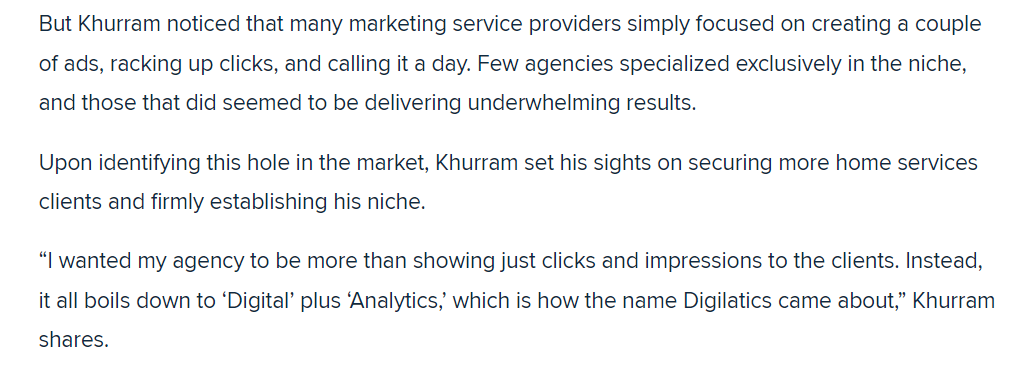
This focused approach, along with consistent delivery on client expectations, has helped Digilatics maintain an impressive 90% client retention rate over the past three years.
How to niche down
There are several ways to narrow down your niche.
You can choose to specialize in a specific industry (e.g., healthcare, finance), a particular service (e.g., SEO, content marketing), or narrow your focus by geography.
What approach is best for you?
Well, it depends on your agency’s goals, strengths, market conditions, and passion.
Four questions to ask yourself:
- What is your agency size and resources?
- Where is market demand growing?
- What are your agency’s long-term goals?
- What is your team passionate about?
Here are the industries considered promising and about to boom in 2025:
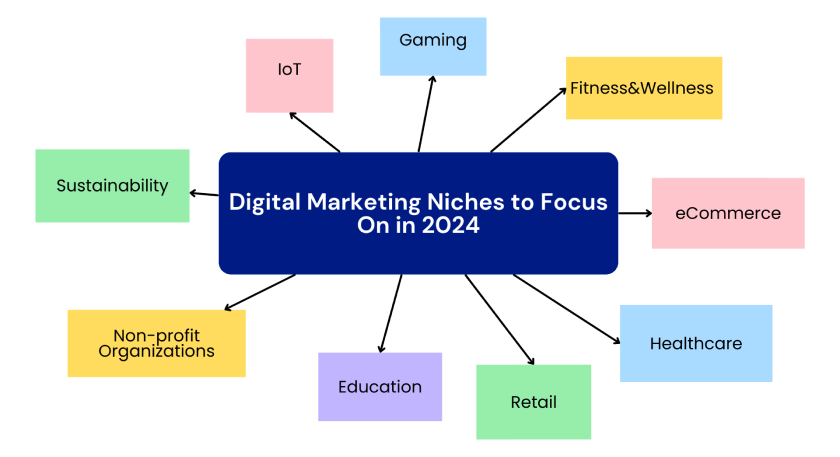
Image source: Digital Agency Network
Small agencies might do well specializing in an industry to build strong relationships, while larger ones can benefit from focusing on one service across different sectors.
Tools like Google Trends, Google Marketplaces, industry forums, and Reddit can help you explore and validate potential niches.
Reference Resources::
- Marketing Agency Growth Insights and Future Channel Strategies
- How To Pick a Niche for Your Agency: A Step-by-Step Framework
- Choosing a Niche for Your Digital Agency: Industries to Focus On in 2025
- “Giving Tree Media” Digital Agency Case Study
#2. Take care of your online presence
People rarely engage with a service provider immediately after a first encounter.
In fact, 97% of people check a company’s online presence before deciding to visit or engage with their business.
Similarly, when clients hear about your agency, they will likely search for you online to learn who you are and assess whether you’re trustworthy.
Your online presence is your calling card. It sets the tone for first impressions, so make sure it presents your agency in the best possible light.
Here’s what to focus on:
2.1. What you sell to people, do best for your agency
If you don’t excel in the services you offer to others, why should people trust you?
For example, if you provide SEO, content marketing, or web design, your own website should excel in those areas.
Clients want to see proof that your strategies work—so treat your own website as your most important client. It should serve as a showcase of your agency’s capabilities.
2.2. Create strong profiles across platforms that your target clients use
Depending on your niche, choose the platforms where you present your profiles.
For example, if you’re in the PPC niche, make sure your agency’s Google My Business profile is optimized.
Your profile should include:
- A professional logo
- A descriptive yet concise bio highlighting the services you offer
- A custom banner properly sized for the platform
- Case studies that clearly demonstrate your agency’s success
Adding case studies to your agency’s profile is critical because they provide tangible evidence of your value.
They show how you’ve helped others achieve measurable results, allowing potential clients to visualize how your services can solve their problems.
This increases trust and the likelihood of conversion.
According to a survey by eMarketer, 62.6% of US marketing agency executives say client case studies are one of the most effective tactics for generating leads.
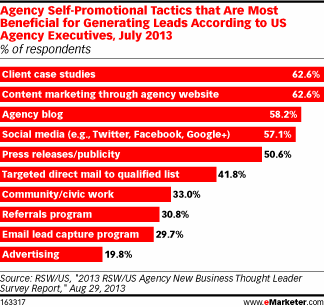
(For practical tips on optimizing case studies for increased lead generation, see strategy #3.)
Reference resources:
- 13 Google My Business Optimizations to Rank Higher in Local Search
- LinkedIn Profile Tips: 18 Research-Backed Ways to Stand Out Professionally
- 21 Ways To Build Your Social Media Presence, Like HubSpot Marketers
#3. Integrate case studies in your profiles, sales, and marketing process
I’ve already emphasized how effective case studies are for generating leads, so let’s move on to two key questions:
- How do you publish case studies that convince potential clients?
- How do new businesses use this strategy if they don’t have significant long-term results to show?
We’ll tackle these one by one.
How to create a case study that converts, not bores
The case study process includes 5 simple steps:
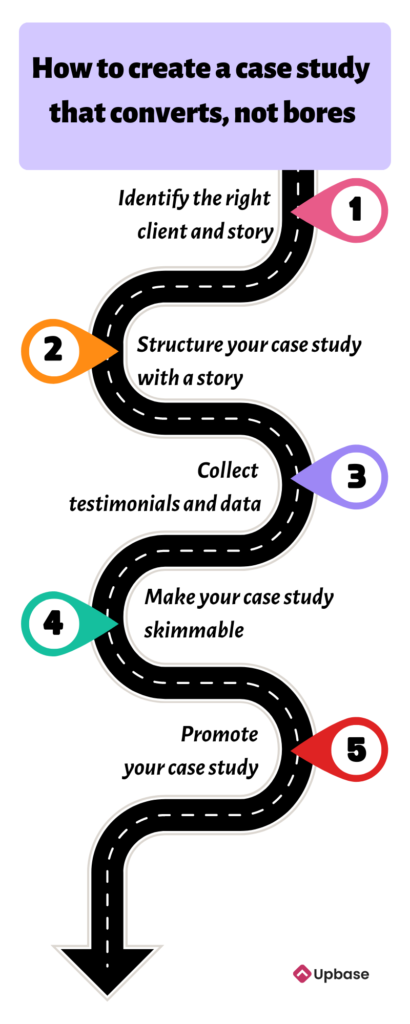
Step 1. Identify the right client and story
Choose a client with a success story that aligns with your target audience’s needs.
Ideally, the client should have experienced significant transformations through your services, such as increased website traffic, higher conversion rates, or boosted sales.
Step 2. Structure your case study with a story
An engaging case study should follow a narrative that helps prospects visualize themselves in the story.
You can use one of these storytelling frameworks:
1) The Hero’s Journey framework by Joseph Campbell — where the client is the hero. The journey begins with the client facing a significant problem, trying conventional solutions, but failing. Eventually, they find your solution and overcome the odds. The story ends with the client’s triumph.
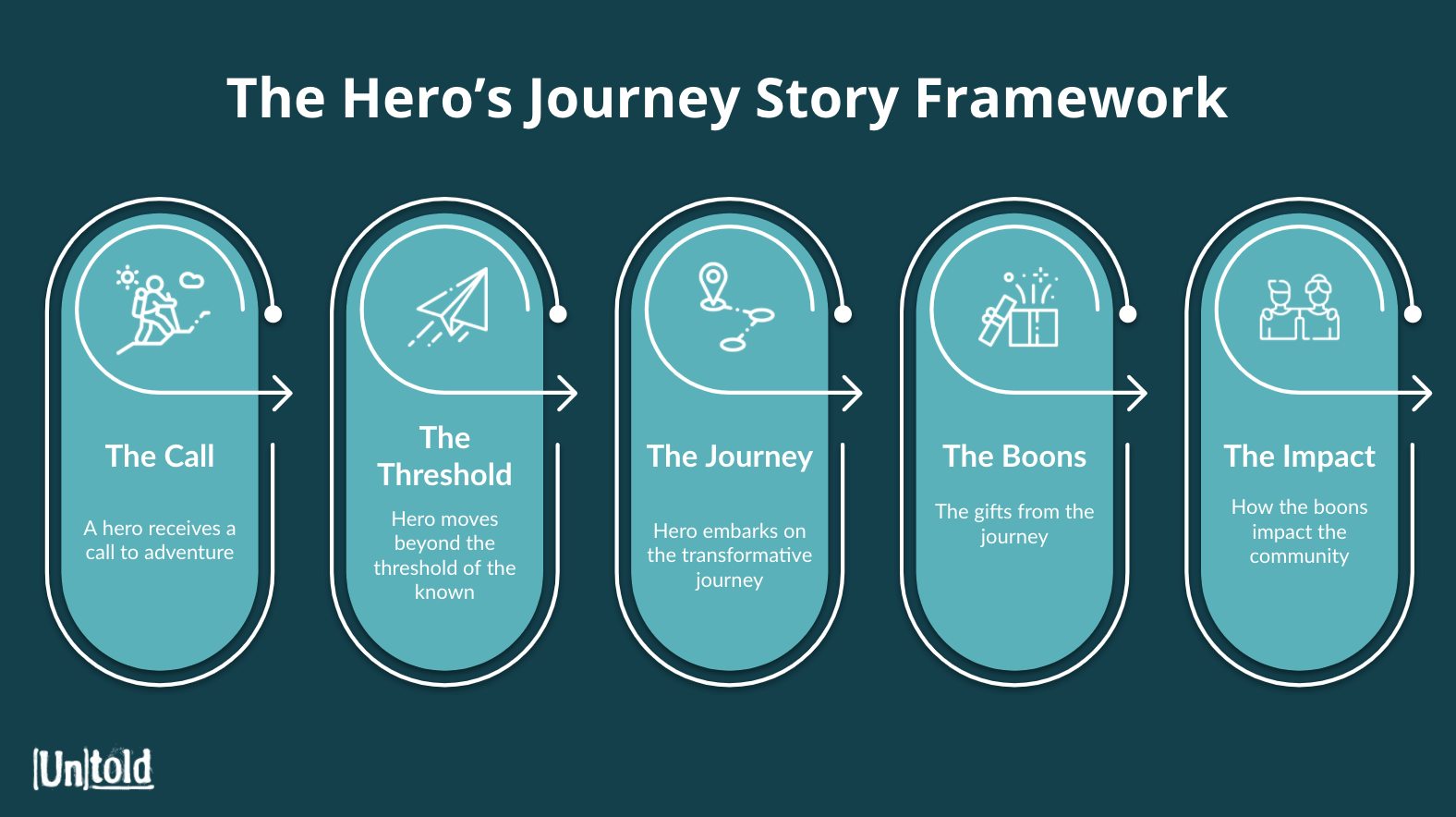
Example to get you inspired: Lucid Meetings case study by HubSpot.
2) The “Case Study Sequence” framework by Steve Slaunwhite — which includes 7 key elements for a well-structured case study.
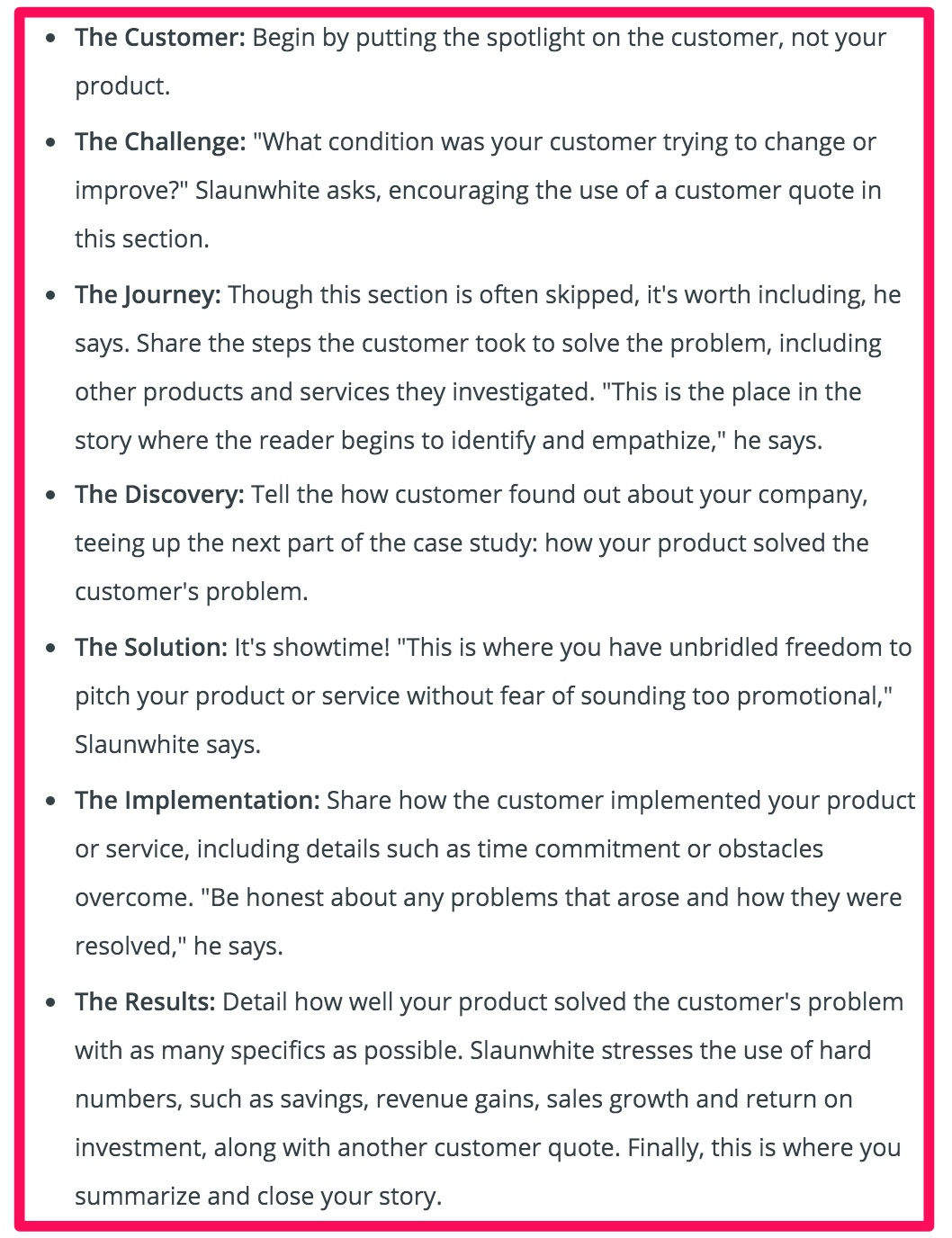
Source: Zapier
Step 3. Collect client testimonials and data
To make your case study more credible, include data-driven results and client testimonials.
During the creation process, interview key decision-makers like the CMO or CEO to highlight how your agency solved their challenges.
- Tip: Strong, concise client quotes can act as powerful social proof throughout the case study.
Step 4. Make your case study skimmable
Most online readers will skim content.
And according to NeilPatel, people only spend an average of 2 minutes and 27 seconds on a page.
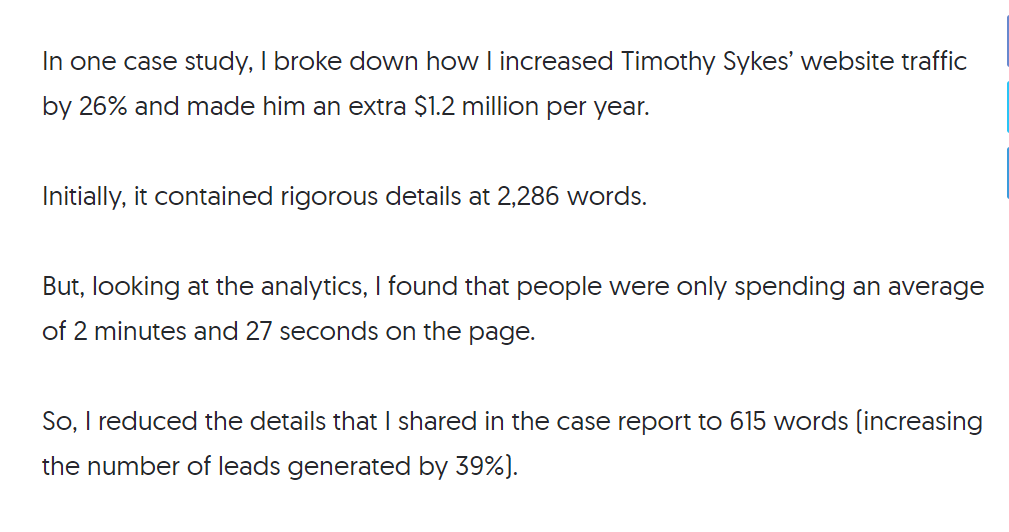
To accommodate this behavior, design your case study for easy navigation:
- Break up long text with bold headings, bullet points, and quotes.
- Use visuals, such as:
- Before-and-after graphs
- Photos of the client
- Key stats in quote boxes
- Alternating background colors to signal new sections
- Before-and-after graphs
This helps readers quickly grasp the key takeaways.
Step 5. Promote your case study effectively
Don’t let your case study sit idle; promote it actively. Here are some practical ways to do that:
1) Sales and Email Marketing: Incorporate links to case studies in follow-up emails and sales pitches, particularly after initial meetings. Agencies like Single Grain have effectively used this tactic to close more deals.
2) Website Placement: Add a dedicated “Case Studies” page to your website and link to it from your homepage or service pages.
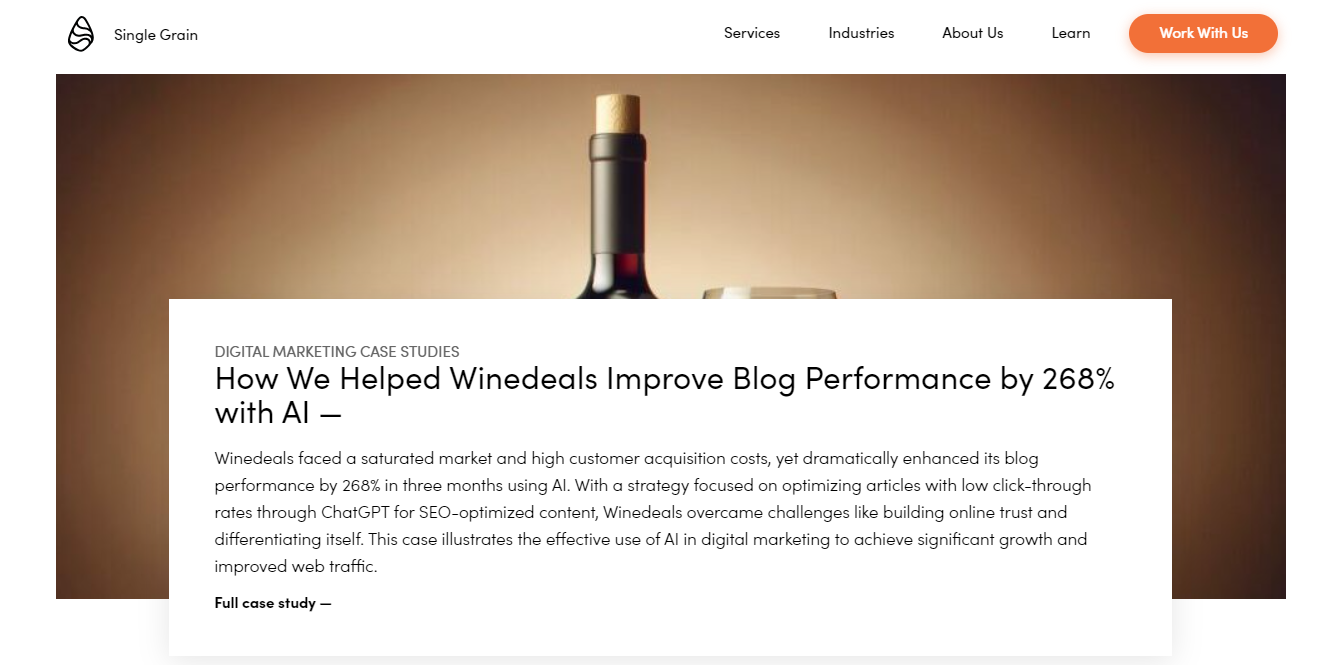
3) Social Media and Blog Posts: Repurpose your case studies into videos, infographics, or social media snippets.
For instance, create a short video summarizing key points and share it on LinkedIn, Facebook, and YouTube.
Tips:
- Use tools like Google Analytics to track how much traffic your case studies generate and whether they convert visitors into clients.
- Conduct A/B testing to refine headlines, layouts, and other elements to improve performance.
- Regularly optimize your case studies by adding updated results or tweaking the design based on performance reports.
How new marketing agencies apply this strategy successfully
The biggest challenge for new agencies is the lack of long-term results. However, there are a few smart approaches to overcome this:
- Use Speculative Work or Hypothetical Projects: If you don’t have actual client results, showcase your potential by creating mock case studies. For example:
- Redesign a popular brand’s website.
- Create marketing campaigns for fictional or hypothetical companies.
- Work on projects you want to attract to show what you can do.
- Redesign a popular brand’s website.
- Showcase Short-Term Wins: Highlight immediate improvements, such as increased traffic, better engagement, or higher conversion rates, to demonstrate the effectiveness of your services.
- Leverage Client Testimonials Early: If you’ve had a few clients or beta testers, gather testimonials as soon as possible. These can serve as proof of your agency’s credibility, even for small projects.
Reference resources:
- How to Write a Case Study: Bookmarkable Guide & Template
- How to Write Better B2B Case Studies: 2 Lessons from Psychology
- The 6 Rules for Creating Powerful Agency Client Case Studies
- 17 Brilliant Case Study Examples To Be Inspired By
#4. Cold Email Outreach
Do emails still work for client acquisition these days?
The answer is yes.
Many marketing agencies still use cold email as their primary strategy to get new clients.
Mezzolab, a full-service digital agency, replaced their income from a few thousand to $40,000 within a month by just using cold emails.
That said, some agencies still fail with this strategy. Prospects don’t reply to their email; a lot of them don’t even bother opening it.
According to Woodpecker, the response rates are 1% to 5% on average, but they can increase up to 30% if done correctly.
How to do cold emailing correctly for high-quality leads and substantial client wins?
Step 1: Choose the Right Approach Based on Your Resources
There are two main approaches to cold email outreach:
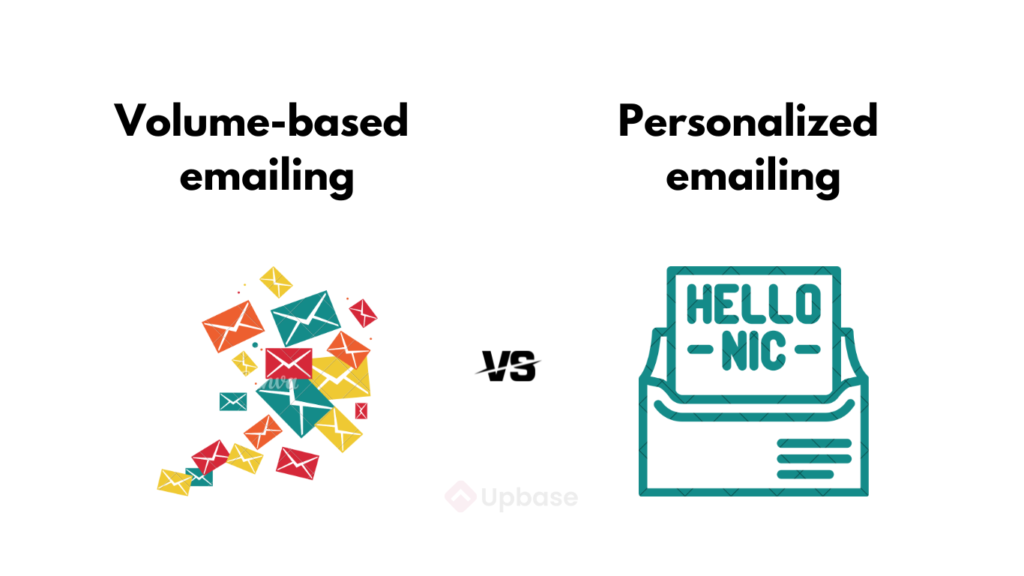
1) Volume-based emailing:
It’s about sending hundreds or even thousands of emails daily using pre-made templates with minor personalizations.
This approach is ideal when your goal is to reach many prospects quickly and at scale.
It’s perfect for solo agencies or those on a tight budget, as automation tools can save time and boost productivity.
2) Personalized emailing:
This strategy involves crafting tailored messages that address specific pain points of your prospects.
Though this method requires more effort, it typically results in higher engagement and conversion rates.
If your agency has more time or budget available, this personalized approach can yield greater long-term success.
Step 2: Create Effective Cold Emails
To stand out in a crowded inbox, avoid generic messages. Your cold emails should be tailored, concise, and deliver value upfront.
Here are some tips for better results:
- Subject Line: Keep it short, clear, and compelling. A/B test multiple subject lines to discover what resonates best with your audience.
- Personalization: Reference specific pain points or opportunities.

- Brevity: Business owners and decision-makers don’t have time to read long emails. Keep your message concise, focusing on a single problem you can solve for them.
- Value Proposition: Offer something of immediate value, such as insights, a free audit, or a personalized video. For example, a web design agency might send a mockup showing potential improvements to a prospect’s website.
Step 3: Leverage Tools for Maximum Outreach Efficiency
Automation and efficiency are crucial for scaling cold email campaigns. Here are some tools to help streamline your efforts:
Scrupp & Instantly.ai: These lead generation tools provide thousands of emails, helping you scale your outreach.
Bulk Email Checker: This tool ensures your email list is clean, reducing the risk of your emails landing in spam folders.
Google Workspace: Use professional email accounts to improve trust and credibility, making your outreach appear more legitimate.
Tips:
- Audience Segmentation: Start with a well-segmented list. Tailor your emails based on the specific needs of each segment, and test different messaging approaches to see what works best.
- Consistency is Key: Cold emailing is a numbers game. It requires consistency and regular refinement of your strategy based on performance metrics.
- Follow-ups Matter: Often, multiple touchpoints are required before a prospect responds. A well-timed follow-up email can dramatically increase your chances of success.
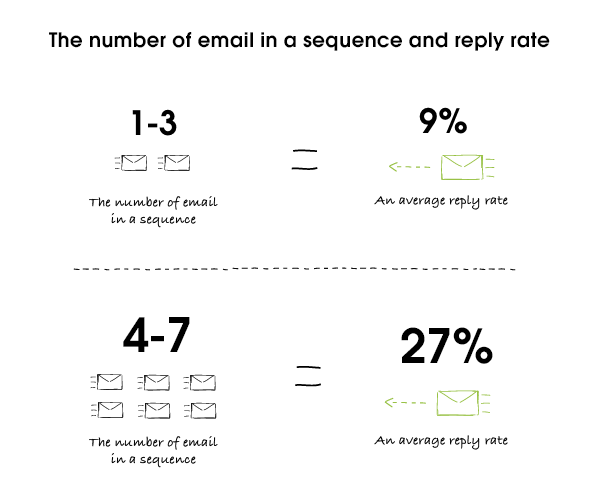
Image source: Woodpecker
Reference Resources:
- The Cold Email Masterclass
- Cold Email Hacks Ebook
- Hunter’s cold email templates
- Cold emails are so badly/under-used… Here’s how you can make them work
- Cold Emails: Can They Work, Or Are They Just Spam?
#5. LinkedIn Marketing
LinkedIn is an increasingly powerful platform for client outreach, with over 990 million users.
Many marketing agencies use it to attract high-value B2B clients.
One Redditor shared this interesting insight: “You can get response rates in the 10-15% range versus email, where it’s 2-3% if you’re doing really well.”
LinkedIn also allows you to target and niche down by location, company size, and other factors. However, scaling LinkedIn outreach can be more challenging than email.
How to market your agency on LinkedIn
Step 1. Optimize your agency profile
First impressions matter, so it’s important to present a professional image. To build trust with your target audience, ensure your agency’s LinkedIn profile is well-crafted. Include:
- A compelling bio showcasing your agency’s mission and services.
- High-quality visuals, such as a professional profile picture and banners.
- Client testimonials or case studies to build credibility.
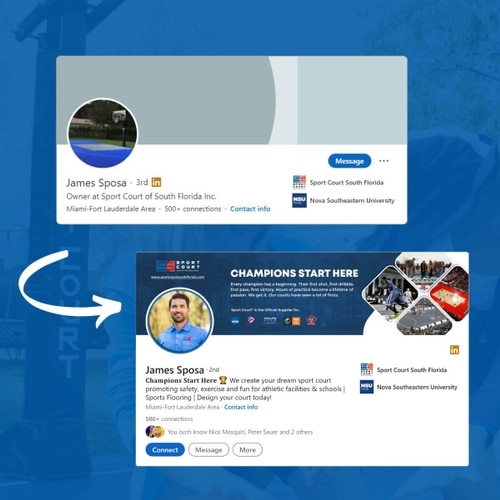
Image source: Intelus
Step 2. Show your expertise and knowledge
Position your agency as an expert by sharing valuable content related to your industry or niche. This can include blogs, whitepapers, videos, or client success stories.
Share insights on the pain points your agency addresses and highlight industry trends.
Tip: Engage consistently by sharing posts and using LinkedIn’s Pulse to publish articles that reach a broader audience.
Step 3. Use LinkedIn Ads for targeted outreach
LinkedIn Ads, including Sponsored Content and InMail, are ideal for targeting decision-makers.
LinkedIn’s advanced targeting options allow you to filter your audience by job title, industry, company size, and professional interests.
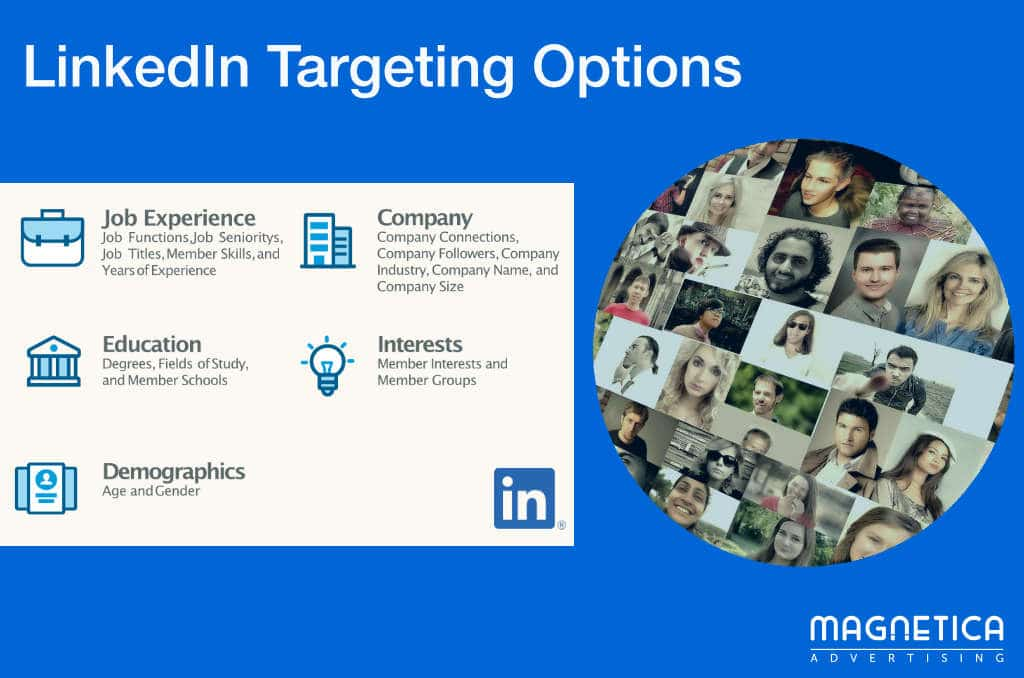
Tips:
- Use LinkedIn’s analytics to track ad performance and adjust strategies accordingly.
- Combining LinkedIn Analytics with Google Analytics can provide deep insights into the performance of your campaigns.
Step 4. Scaling outreach with LinkedIn Sales Navigator & Automation
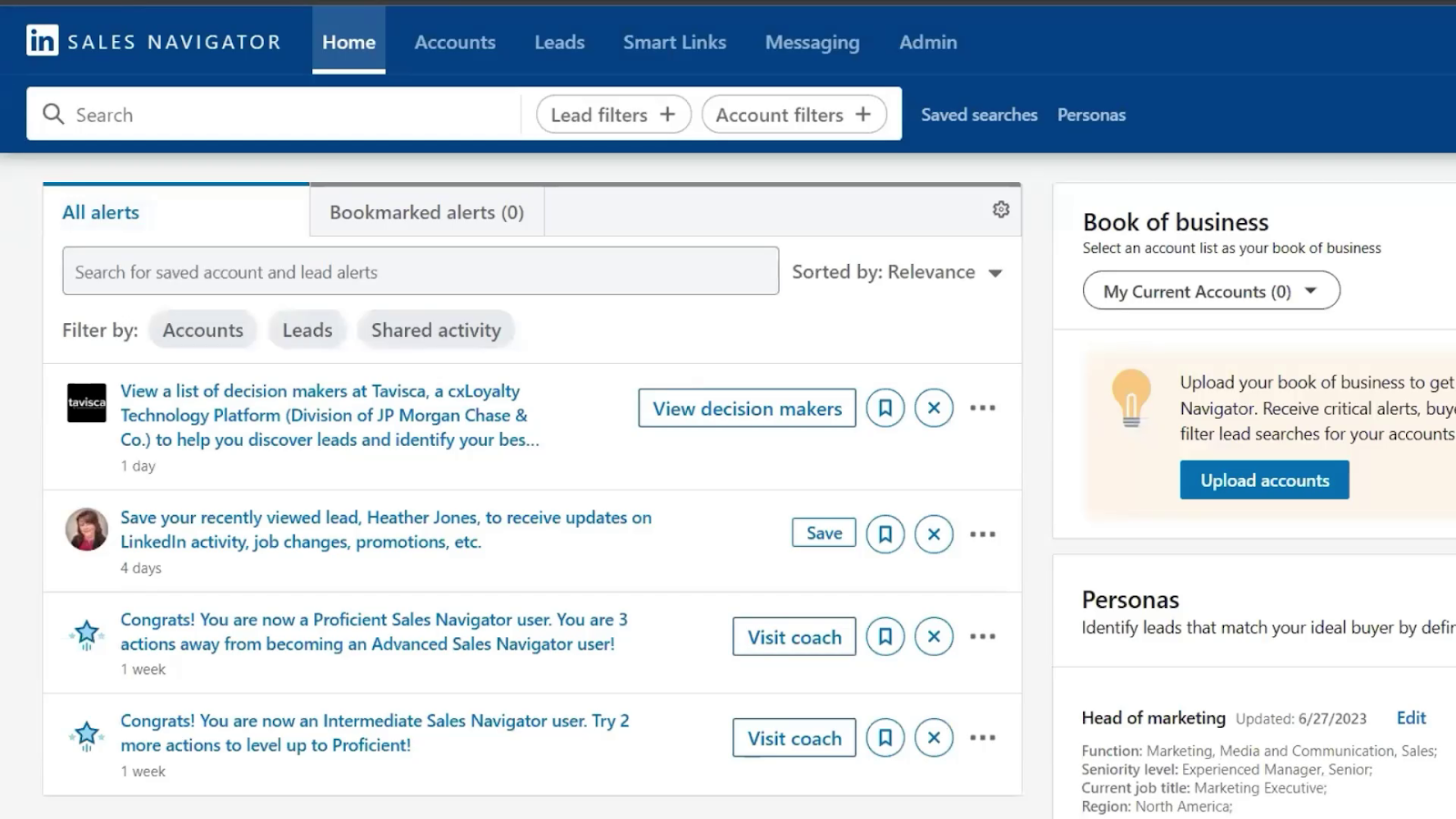
LinkedIn Sales Navigator is invaluable for narrowing down leads based on advanced criteria such as company growth or executive roles.
Agencies can automate outreach through personalized messaging sequences to keep prospects engaged.
For example, B2Linked used Sales Navigator along with automated follow-up sequences to stay top-of-mind, leading to consistent lead generation.
Tip: Automate follow-ups after initial engagement to nurture relationships without overwhelming manual work. Combine personalization with scale for optimal impact.
Step 5. Run Targeted Ad Campaigns
LinkedIn’s precise ad-targeting features help you reach decision-makers directly. You can segment your audience by job title, skills, company size, or industry.
Case studies and educational content are particularly effective for driving engagement from your target audience.
Reference Resources:
- The Beginner’s Guide to LinkedIn Marketing
- LinkedIn Unlocked (Course)
- LinkedIn Organic Playbook
- LinkedIn Automation: Overview of 4 Common Problems + Solutions (For Agency Owners)
- 13 LinkedIn Marketing Strategies You Wish You Created & Why They Work
#6. Create SEO-optimized niche content that serves your target clients
This strategy is effective for reaching a wide audience.
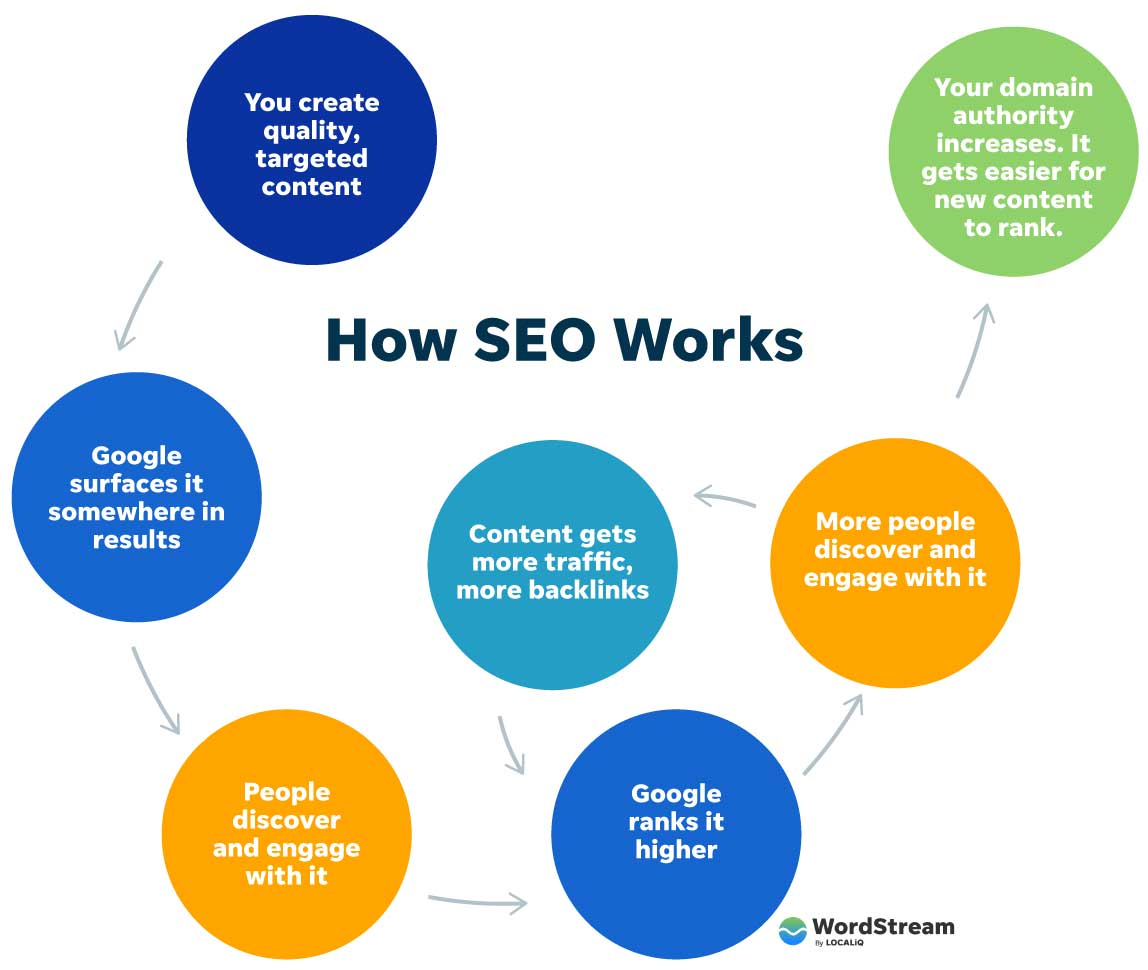
The nature of SEO-optimized content is a long marketing cycle with a short sales cycle.
Clients gained through this strategy are easier to close because they already trust you. Plus, it provides a steady flow of clients over time.
What makes a successful content marketing strategy? Two major components:
- Consistently creating high-quality content that resonates with your target audience, and
- Promoting it effectively.
Directive, a SaaS marketing agency, became a leader in the space by following this strategy.
They dominate search results for competitive B2B SaaS marketing keywords, leading to a steady stream of inbound leads and establishing them as experts in their niche.
How to create SEO-optimized niche content
Step 1. Understand your target audience
You need to know what problems your audience is trying to solve, what information they seek, and how they prefer to consume content.
To gather insights, survey existing clients, use tools like Google Analytics, or explore industry forums to understand common pain points.
Step 2. Research and choose relevant keywords
Look for long-tail keywords with lower competition but high intent, meaning users are looking for a solution or service.

Tools like Ahrefs, SEMrush, or Google Keyword Planner can help identify high-impact keywords relevant to your niche.
If you don’t know where to start, here are some practices:
1) Find blogs/websites in your niche with a lower Domain Rating (DR) than yours. Analyze the keywords they rank for in the top 10 search results, then create better content with stronger SEO optimization.
2) Look for blogs/websites in your niche with a similar or slightly higher DR. Identify content gaps and fill them with your content.
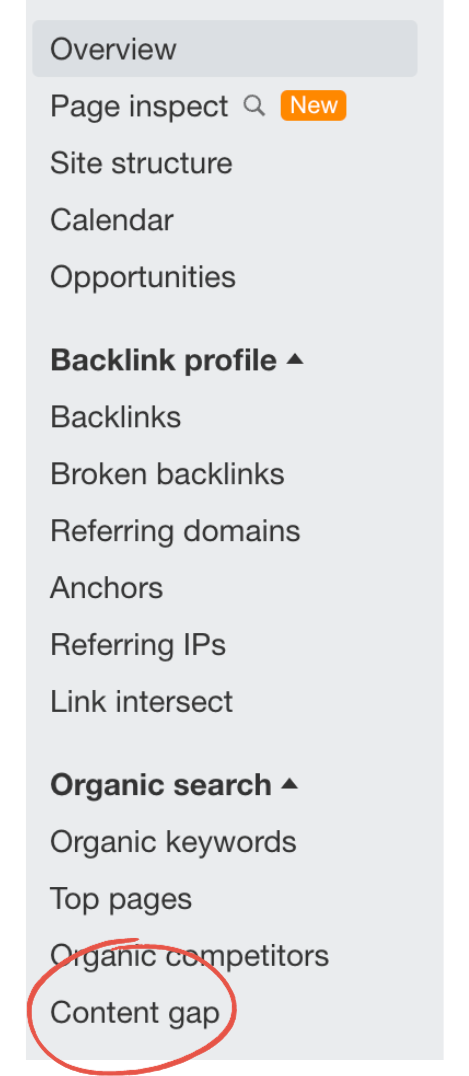
Pro Tip: Be the first to publish content on trendy niche-relevant keywords.
This type of keywords has high search volumes with little competition, giving you an advantage if you’re the first to create content.
But the thing is: Tools like Ahrefs and SEMrush often rely on historical data, which might not capture emerging trends as quickly.
Therefore, you have to find these keywords manually. Here are some practices:
- Use Google Autocomplete and Related Searches: Start typing niche-specific terms into Google’s search bar, and its autocomplete feature will suggest popular searches in real-time. Similarly, at the bottom of the search results page, Google provides “related searches” which offer insights into what users are looking for around that topic.
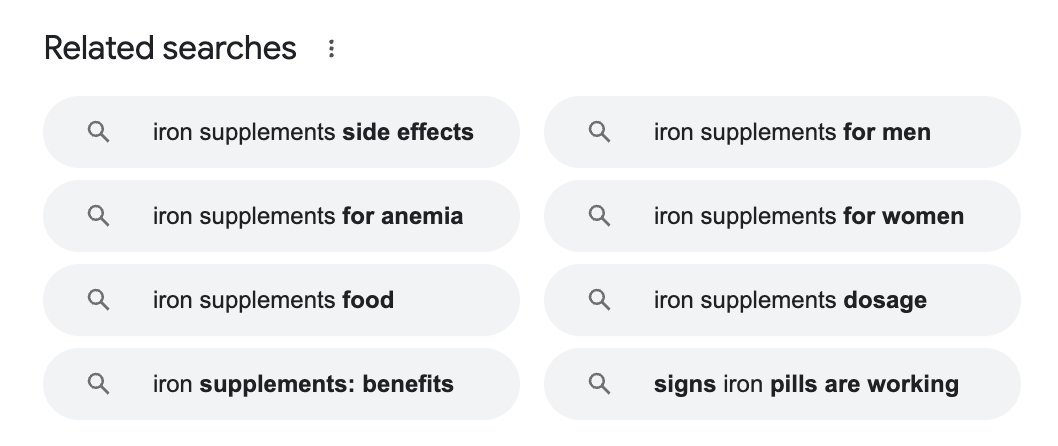
- Monitor communities or subreddits related to your niche on Reddit and niche forums.
- Use Google Trends and filter searches by region or category.
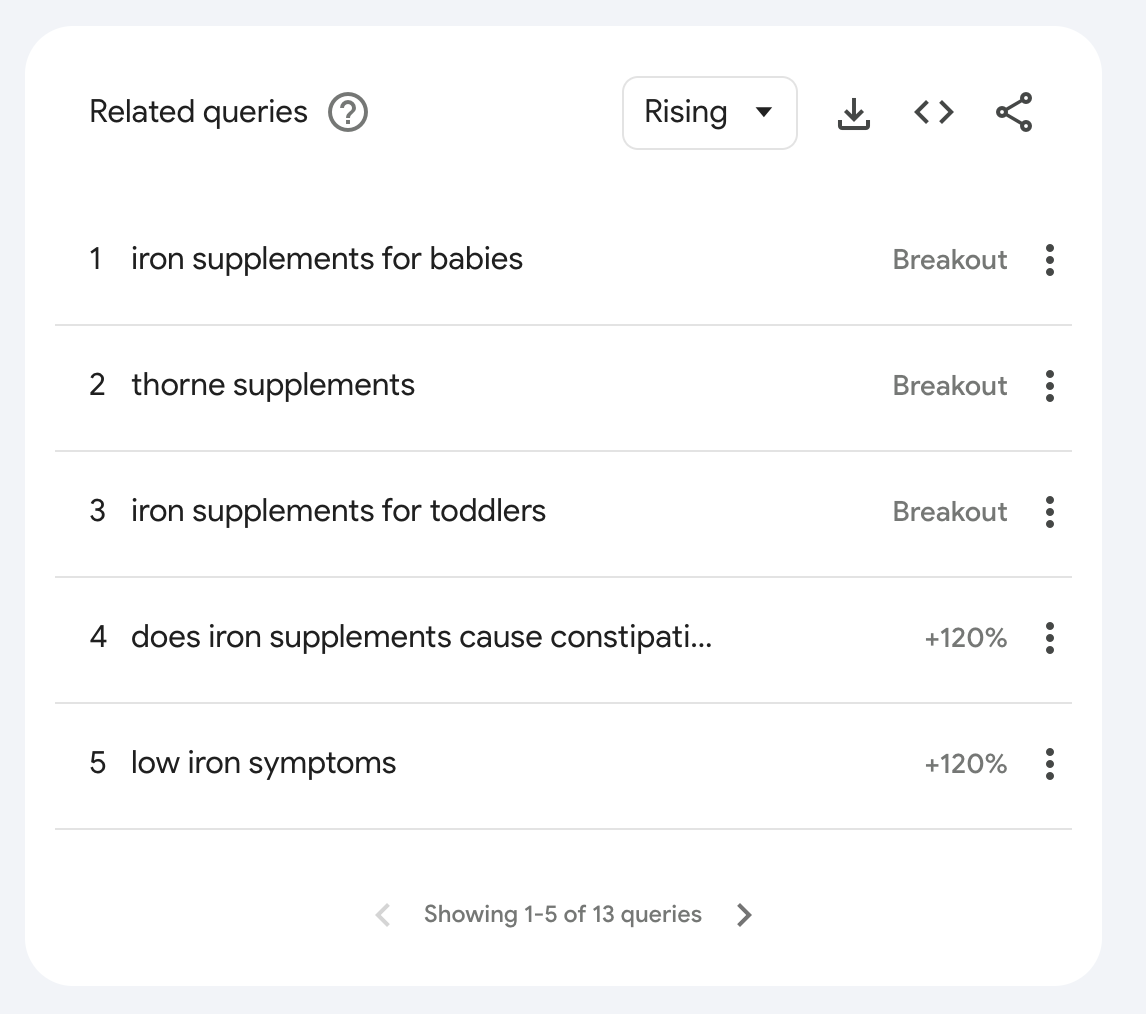
- Follow relevant industry hashtags, popular influencers, and niche-specific forums on social media platforms like X and LinkedIn.
Step 3. Create in-depth, valuable content with SEO optimization
Focus on producing content that genuinely solves your audience’s problems.
Common types of content include how-to guides and tutorials, case studies, in-depth industry reports, and infographics.
Remember to format your content for easy readability—use headings, subheadings, bullet points, and short paragraphs.
Ensure your content is optimized for both users and search engines by:
- Using descriptive meta tags and titles.
- Keyword-optimizing your content.
- Adding internal and external links to reputable sources.
- Compressing images and optimizing for site speed.
- Implementing local SEO strategies if applicable.
Step 4. Promote your content
Great content won’t attract clients if it remains hidden. Use multiple channels to promote it.
Start with organic promotion through social media groups, email outreach, and collaborations.
Agencies like ClearVoice partner with influencers and brands to co-create and distribute content, significantly increasing their reach.
Paid advertising, though effective, should be reserved for content that has proven value and traction.
Tips:
- Consistency is key. If you don’t have a dedicated content team, start small by creating one or two in-depth articles a month. Alternatively, you can outsource to freelancers or content creation agencies to keep your production consistent.
- To maximize your content’s lifespan, repurpose it across different mediums (see Strategy #7).
Reference resources:
- Follow My SEO Content Creation Process: How I Rank #1 on Google
- SEO Writing: 16 Tips for Creating SEO-Optimized Content
- 25 Ways to Have SEO Success with Google
- How to Create an SEO Strategy for 2025 [Template Included]
#7. Repurpose Content for Various Platforms
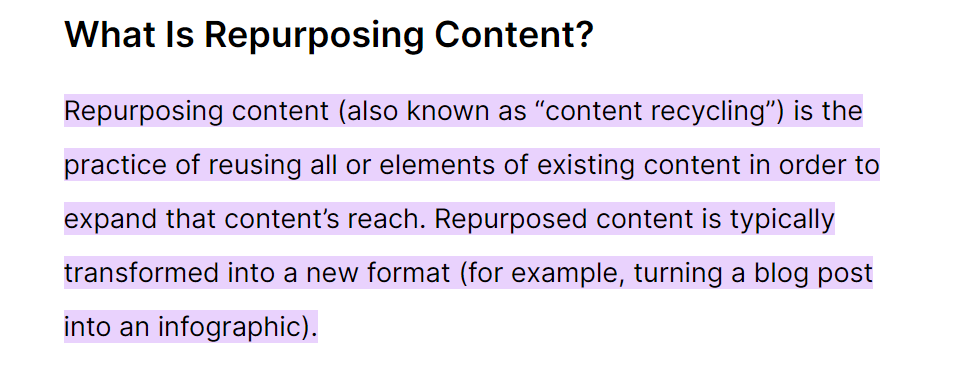
Source: Backlinko
One great way to maximize your content’s lifespan and extend its reach is by repurposing it across different mediums.
For example, a blog post can be transformed into a video, podcast episode, or a series of social media snippets. This amplifies your reach and engages potential clients in various formats.
How to repurpose content effectively
Step 1. Identify high-performing content
Here’s how:
Login to your Google Analytics -> Behavior -> Site Content -> All Pages -> sort by by Pageviews
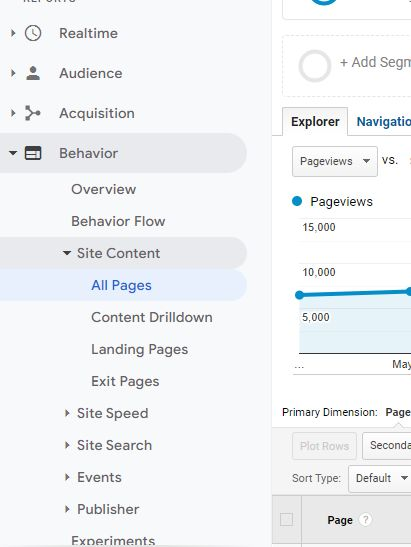
Image source: NeilPatel
Review your existing content and identify pieces that have resonated with your audience.
Content that has received the most engagement, traffic, or shares is ideal for repurposing.
Tips:
- Find the most viewed content pieces from the previous month.
- If there are multiple candidates, prioritize evergreen content or topics, as they consistently perform well over time.
Step 2. Transform and adapt content for specific platforms
Repurposing content effectively means not just changing the format but also tailoring it to match the expectations and preferences of each platform’s audience.
For example:
- Videos: Turn blog posts into engaging YouTube or Instagram videos by summarizing key points or providing demonstrations. See strategy #8.
- Infographics: Create visually engaging infographics from data-rich content like case studies or reports to share on Pinterest or LinkedIn.
- Podcasts or Audio Clips: Convert long-form blog posts or interviews into podcasts or short audio clips for platforms like Spotify or Apple Podcasts.
- Social Media Posts: Break down longer articles into bite-sized social media posts with compelling images, graphics, or text snippets that align with Instagram, Twitter, or LinkedIn’s content formats.
Moz’s Whiteboard Friday series is a successful example of taking in-depth SEO guides and transforming them into educational video content that is shared across platforms like YouTube and LinkedIn.
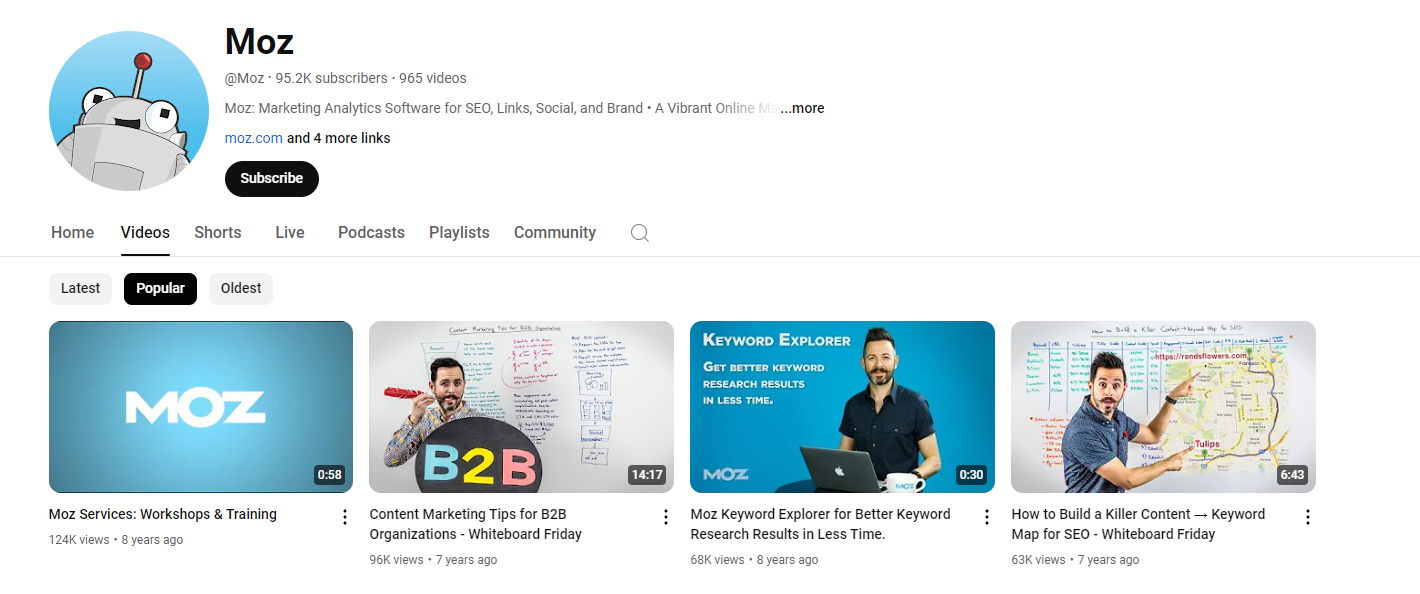
Tip: If you have a limited budget or resources, consider using AI tools like Descript, Vidyo.ai, Pictory AI, or Canva AI.
Step 3. Segment and break down content
Longer pieces of content, such as whitepapers, eBooks, or comprehensive guides, can be broken down into smaller, more digestible pieces.
This segmented content can be repurposed into a series of social media posts, email newsletters, or shorter blog articles, helping keep your audience engaged with bite-sized information.
For example, Brian Dean split his 14-minute YouTube video into a short 11-second clip that featured the best tip and then posted it on LinkedIn.
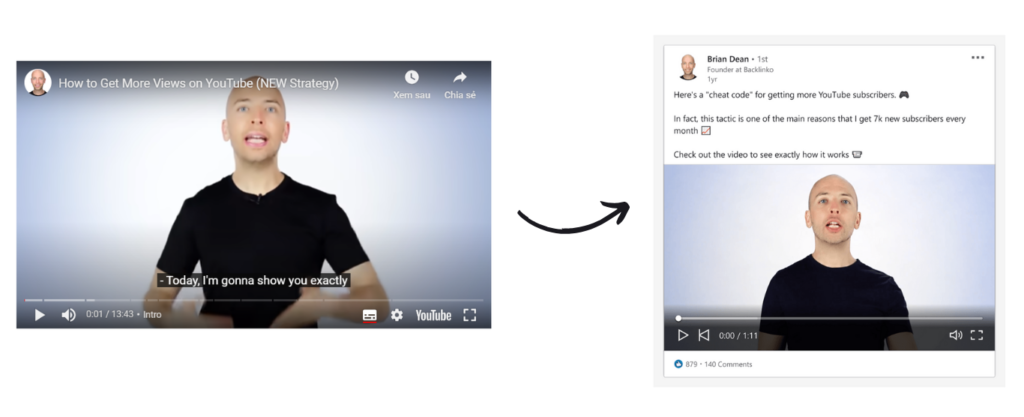
Step 4. Use data and user feedback for optimization
Leverage analytics to determine which content types perform best on each platform. This allows you to continuously optimize your repurposed content based on real engagement and conversion metrics.
Step 5. Create a Workflow for Efficient Repurposing
Establish a system or workflow for repurposing content.
This helps streamline the process and ensures that no content gets left behind.
Use a comprehensive project management tool like Upbase to manage the process, and also make use of its calendar feature to track when and where content is repurposed.
Here is a sample workflow we created with Upbase for your inspiration:
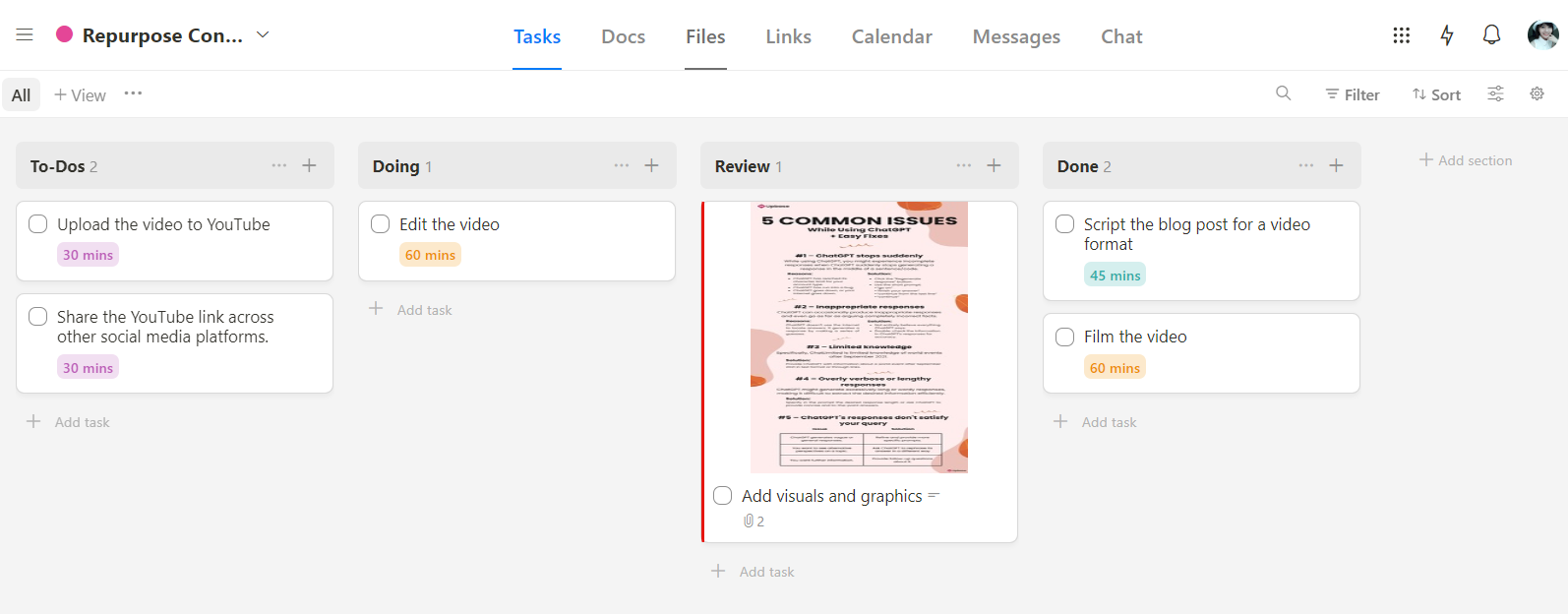
Points to remember:
- Ensure the message is tailored to the audience and the platform’s format.
- Experiment with various forms of content and gather user feedback to refine your strategy.
Reference resources:
- 20 Creative Ways To Repurpose Content – by HubSpot
- The Ultimate Guide to Repurposing Video Content – by Pictory
#6. Video marketing
Video marketing is more powerful than ever.
According a recent survey by Wyzowl, 90% of marketers agree video increases brand awareness, with 87% claiming that video has directly boosted their sales.
YouTube, Facebook, Instagram, and LinkedIn are the most effective platforms in driving video marketing efforts.
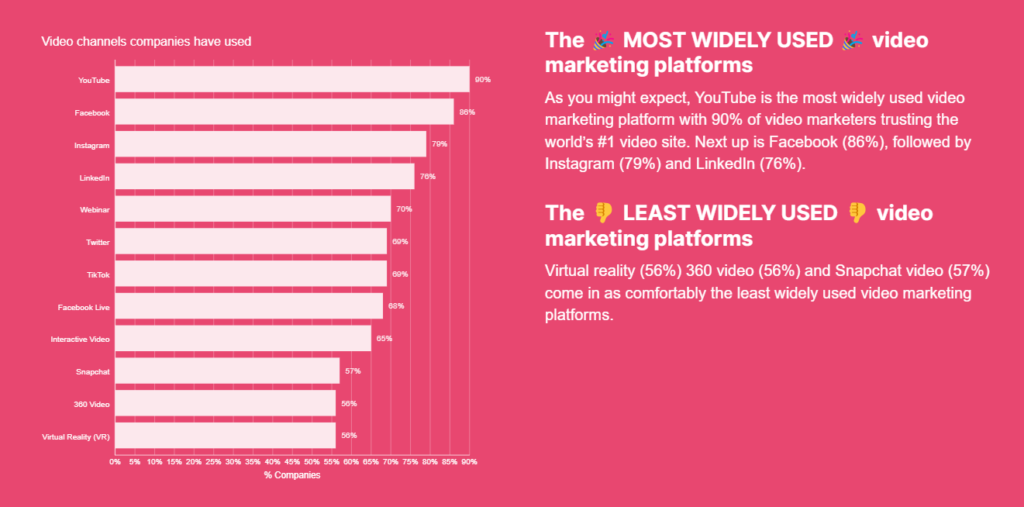
Source: Wyzowl
YouTube dominates, with 90% of marketers using it as a key part of client outreach. Facebook excels in organic engagement. And on LinkedIn, video posts are shared 20 times more than other types of content.
To maximize results, focus on creating high-quality, engaging content tailored to the audience of each platform.
How to succeed in video marketing
Step 1. Experiment on various platforms.
Test different platforms to see where your prospects are coming from.
Use video analytics tools to measure the results, focusing on metrics like view counts, watch times, and engagement (shares, comments).
Agencies like Wyzowl and Vidyard report that:
- LinkedIn has proven to be the most effective for B2B outreach.
- Facebook and Instagram are more effective for B2C.
Step 2. Focus on the content that resonates with their audience
Start by creating several video types and testing them with different audiences to gauge response.
Then, measure viewer engagement and optimize content based on what works best.
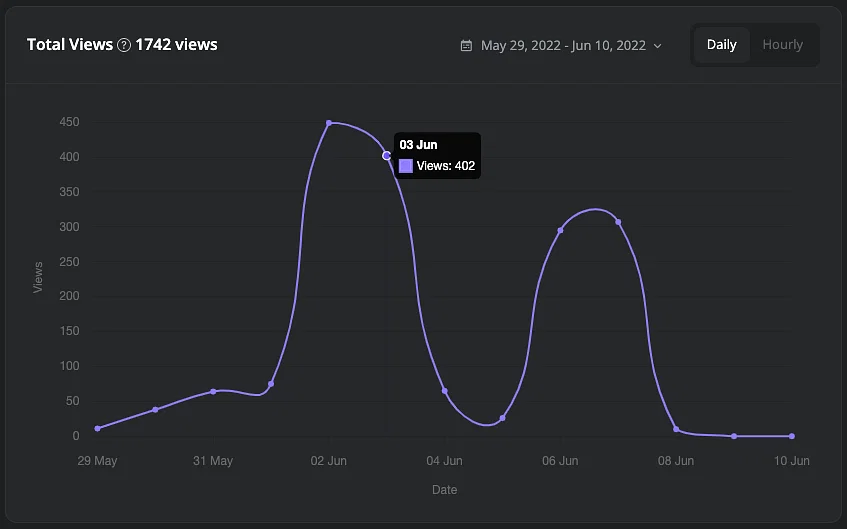
Image source: Gumlet
Tips for optimizing video marketing on specific platforms:
- Short and engaging videos on LinkedIn bring high viewer intention, with the sweet spot being 30-90 seconds
- Videos designed for silent viewing with captions perform well on Facebook.
- Live video, particularly on platforms like Facebook and YouTube, brings a significant increase in real-time engagement.
- Explainer videos, customer testimonials, and behind-the-scenes videos are consistently top performers because they build trust and authenticity.
How to produce videos in a cost-effective way
Small agencies often hire freelance videographers, while those with tight budgets opt to produce videos themselves.
Expensive gear isn’t necessary to create engaging content.
Many successful small agencies start with a decent smartphone camera, good natural lighting, and simple tripods or mounts.
For example, Gary Vaynerchuk built his video-driven personal brand using nothing more than a handheld camera and raw, unedited footage in the early days.
Use platforms like Instagram Reels, TikTok, and LinkedIn, which favor authenticity and engagement over high production value, making them ideal for agencies with limited budgets.
Tips for making better videos:
- Learn video production through online tutorials, YouTube channels, or platforms like Skillshare and Udemy.
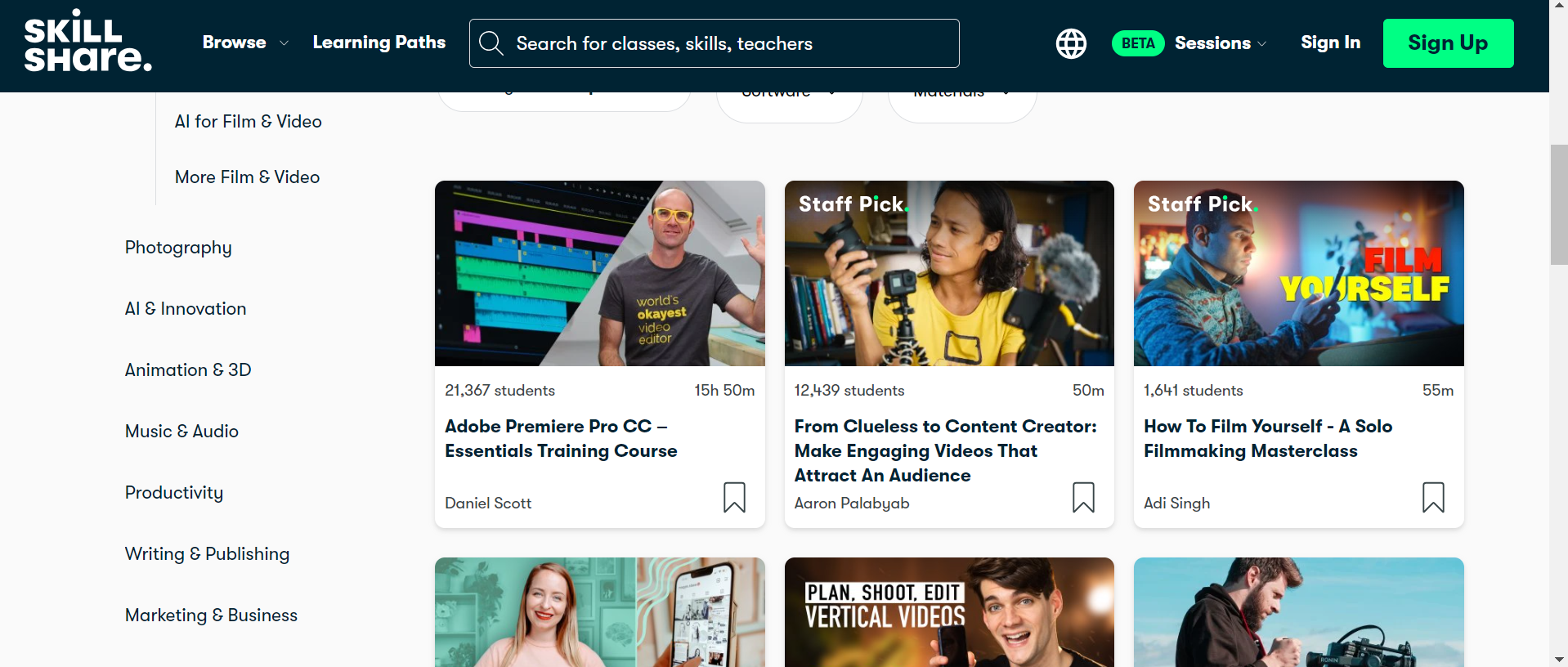
- Use video editing tools. Some popular free options are iMovie, Adobe Spark, or Canva — they offer templates and easy editing features.
- Record multiple videos in one session (batch content creation) to save time and resources.
Reference resources:
- Vidyard’s Ultimate Video Marketing Guide
- YouTube marketing: A complete guide for your brand in 2025
- TikTok marketing: The complete guide for brands in 2025
#9. Offering Free Tools or Resources
This is a tried-and-true tactic to reach a broad audience.
The idea is to offer something so valuable that potential clients feel compelled to take the next step toward paid services.
It could be an SEO audit tool, a social media calendar template, or a performance dashboard—offered without any upfront commitment.
For example, Sprocket Rocket allows users to create a free account and start building HubSpot pages on their platform. After the free trial, many return for more personalized services, converting free users into paying customers.
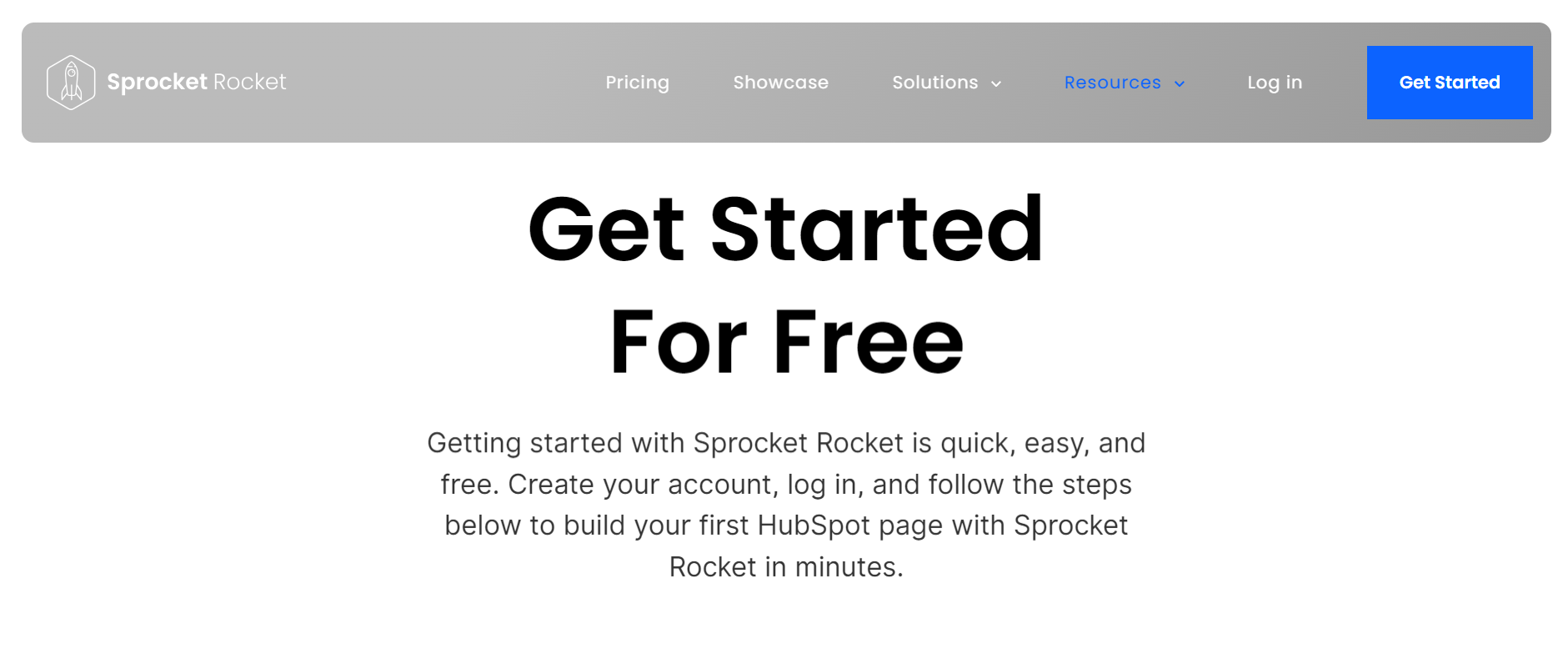
Similarly, GMB Gorilla used a free one-time optimization service, which acted as a “paid trial,” to showcase his team’s Google My Business (GMB) management service.
This brings 95% conversion rate from the paid trial to the recurring Google My Business management subscription.
How to capture leads through free offerings
Step 1. Choose the right tool/resource to offer for free.
Your free tool or resource should meet two key criteria:
- It solves a real problem for your target clients.
- It reflects your agency’s core strengths and services.
Conducting online surveys is a great way to understand what challenges your audience struggles with the most.
Free tools like Google Forms, SurveyMonkey, or Typeform can help you create quick surveys.
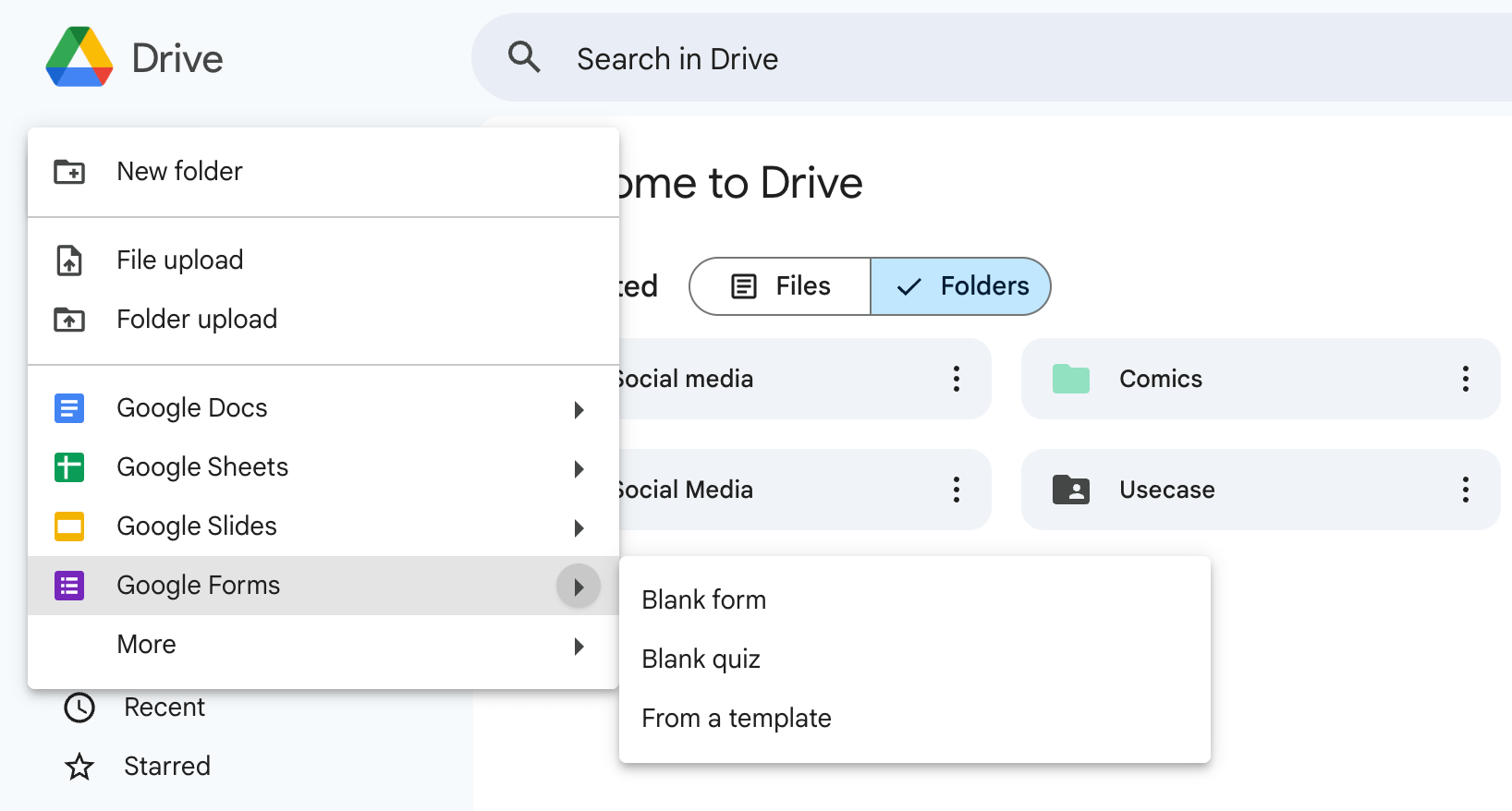
Be mindful of the questions you’re going to ask people. Aim to make respondents share deep insights.
Tip: Instead of only multiple-choice questions, include open-ended prompts. Something like:
- “What is the biggest challenge you face in [specific area]?”
- “What is the most time-consuming aspect of your marketing strategy?”
- “Which tools or services do you currently use but are not satisfied with?”
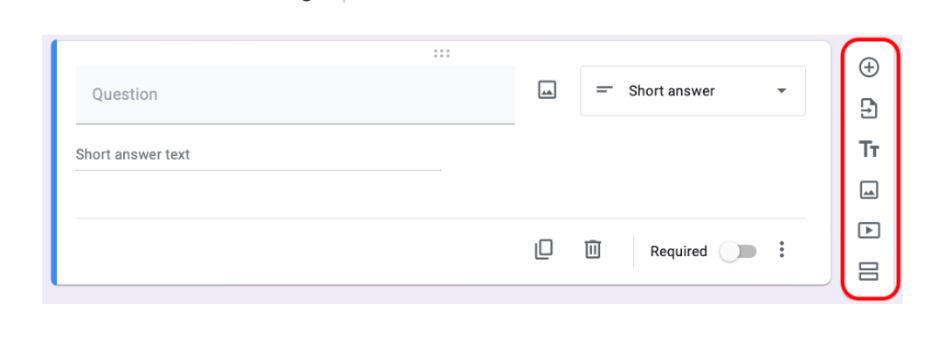
Other useful tactics include monitoring relevant forums and social media groups, as well as consulting your current clients.
Step 2. Build or source the tool
If it’s a simple tool, you can use drag-and-drop website builders or software like Google Sheets for templates or dashboards.
For more complex tools, consider hiring freelancers or developers through platforms like Upwork or Fiverr to create custom solutions.
Don’t forget to implement lead generation mechanisms.
Make sure users must provide their contact information, such as an email address, before accessing the resource. Most agencies use a form on their website for this purpose.
Alternatively, you can use marketing automation tools like Mailchimp or HubSpot to segment leads and follow up with tailored offers.
Step 3. Promote the tool and track its performance
Make sure your audience knows about your free offering.
An effective way is to share it across multiple platforms—your website, social media, and email lists.
For example, Sprocket Rocket uses LinkedIn and HubSpot communities to promote their free templates.
Neil Patel promotes Ubersuggest through his blog and YouTube channels, which drives organic traffic to his tool.
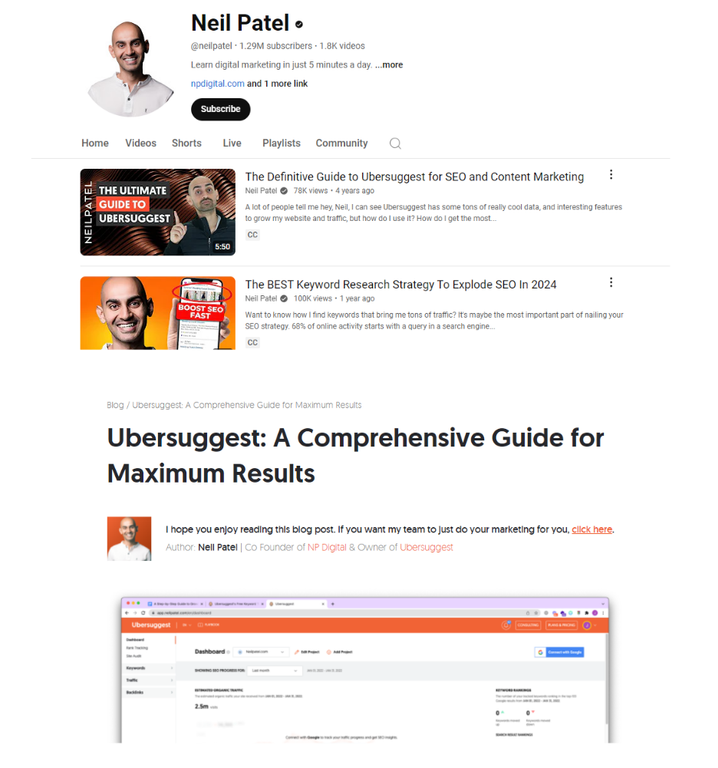
If applicable, consider using paid advertising to expand your reach.
It’s also important to use tools like Google Analytics, HubSpot, or Databox to monitor how many users are signing up, how long they engage with the tool, and which leads convert into clients.
Step 4. Optimize and scale
Once you have gathered data on the performance of your free tool, tweak it based on feedback.
You can also add new features to the tool or create additional resources to further engage your audience.
Pro Tips:
- Offer a basic version of the tool for free, but include paid features for users who want more in-depth functionality.
- Develop an onboarding sequence that helps users maximize the tool’s value. This can increase the chances of conversion.
- Keep your tools fresh with updates, as this will keep users engaged and showcase your expertise.
#10. Community Building
“A brand-owned community gives brands direct access to customers and fans with no restrictions from the large social platforms.”
– Forbes.
Community building isn’t just a versatile strategy—it’s foundational.
It helps agencies of all sizes establish authority, engage prospects, and generate organic referrals, while fostering long-term client relationships.
Plus, the strategy scales effortlessly, whether for niche industries or broad B2B and B2C audiences.
How to build a community that converts
Step 1. Nail down who you’re targeting.
It’s not enough to broadly say “small businesses” or “tech startups.” Dive deep into understanding their challenges, aspirations, and what motivates them to engage.
Step 2. Identify where your ideal client spends time
Every platform serves a unique purpose.
LinkedIn works well for B2B audiences, while Facebook groups or Reddit threads might engage B2C clients.
For smaller, more intimate communities, Slack or Discord can be invaluable for creating real-time conversations.
For example, Impactable, a B2B LinkedIn Ads Agency, nurtures its community through YouTube podcasts, driving both visibility and trust.
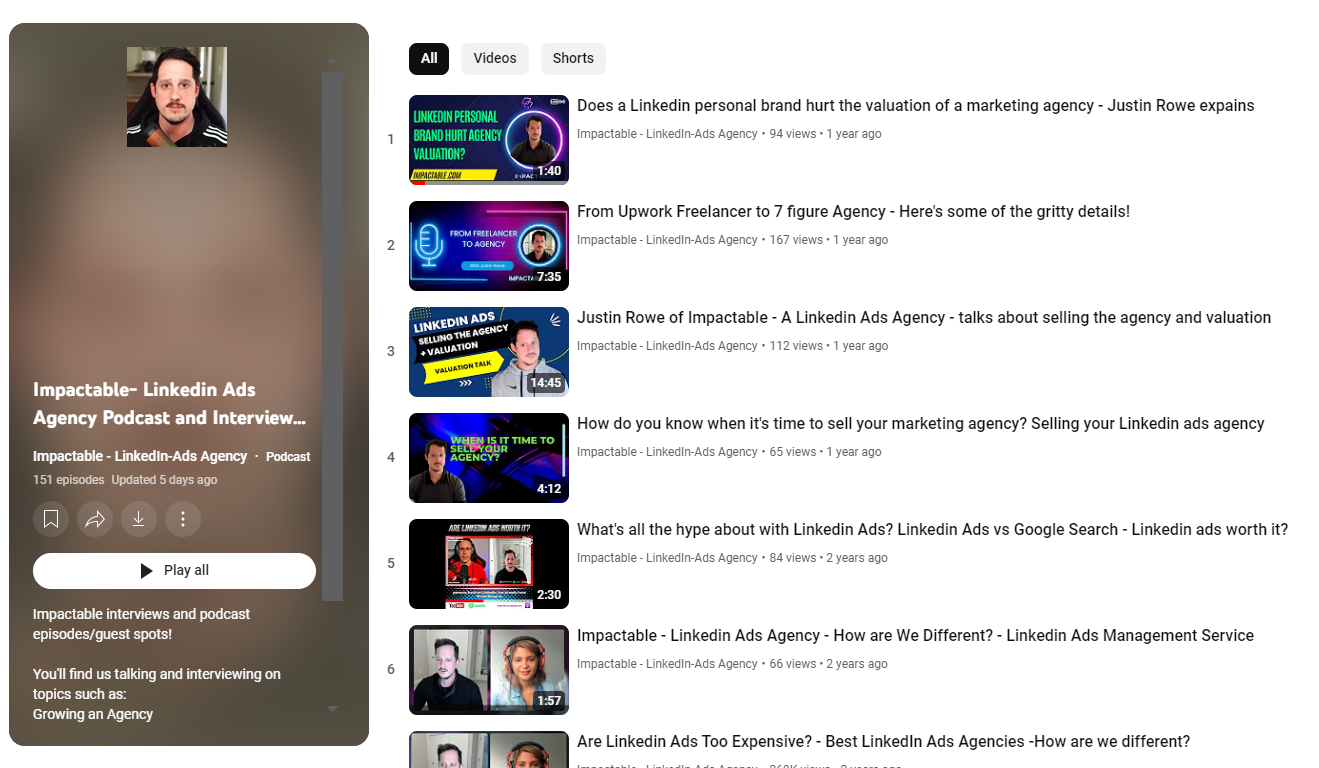
Step 3. Provide value before selling.
Successful communities aren’t built on hard sales tactics—they thrive on value.
The trust you build by consistently providing value is what ultimately leads to conversions.
Therefore, you should focus on educating your audience through webinars, blog posts, or case study breakdowns.
Offer practical tools, templates, or tips that demonstrate your expertise while meeting their needs.
I’ve seen agencies like Animalz, a content marketing agency, flourish by sharing their knowledge with communities via multiple podcast platforms.
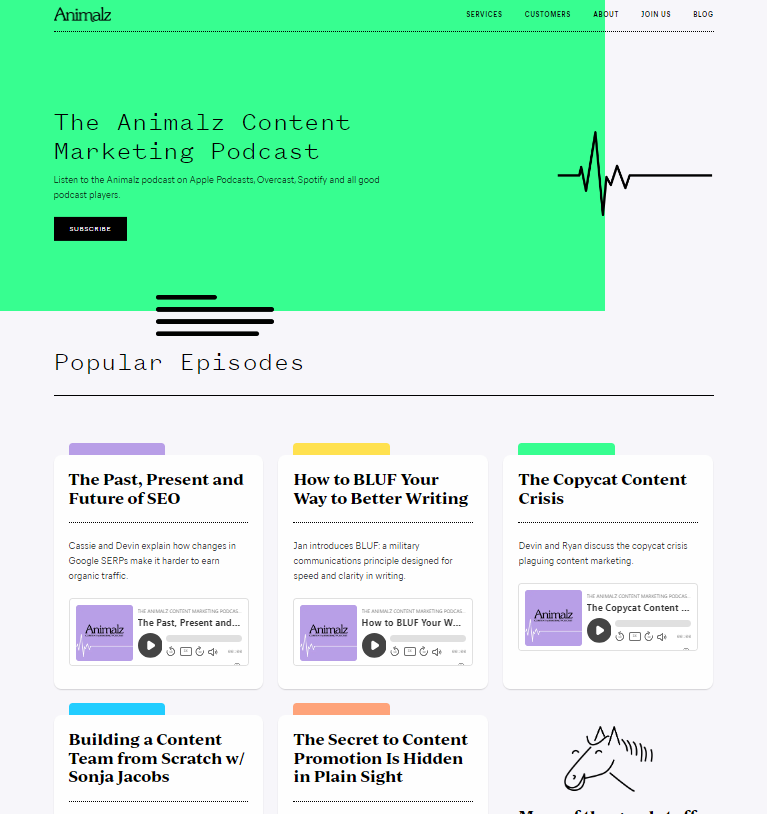
This doesn’t just serve their current clients but continuously attracts new ones.
Step 4. Create an engaging and comfortable atmosphere
The more engagement you encourage, the more likely your community becomes self-sustaining.
This also helps build deep relationships with potential clients before they even enter a sales conversation.
Host AMAs (Ask Me Anything sessions), initiate thoughtful discussions, or encourage members to share their own experiences.
Tips:
- Share client success stories and testimonials within your community to establish trust.
- Set clear boundaries and commit time. Many successful agencies recommend dedicating an hour a day to engaging with your community. No client work, no distractions—just focused time to nurture relationships.
- Use guest contributions, if possible. This helps bolster your authority, attract new members, and boost your reputation. Invite influencers or respected industry professionals to speak to your webinars, interviews, or Q&A sessions.
Reference resources:
- The Ultimate Guide to Community Management
- Build an Engaged Online Community With These Tested Strategies
#11. Online Directories and Listings
Online listings are another effective way marketing agencies can acquire clients.
This strategy offers benefits for both startups and established agencies.
For startups, online listings provide an affordable way to gain initial exposure and attract clients without heavy investment in advertising.
For established agencies, these listings help strengthen reputation and improve SEO.
Many niche-specific platforms are available, most of which allow you to create a free profile. Popular websites include:
- Google My Business — Ideal for improving local SEO and being discovered by clients in your area.
- Clutch — Specializes in connecting clients with agencies that offer services like SEO, web development, and PPC management.
- UpCity and DesignRush — These directories have extensive reach and cater to various digital marketing niches. They build credibility through client reviews and are frequently used by businesses searching for agencies.
For example, Mayple gained significant visibility and clients by being listed as a top marketing agency on Clutch and similar platforms. Their profile and reviews led to inbound inquiries from potential clients.
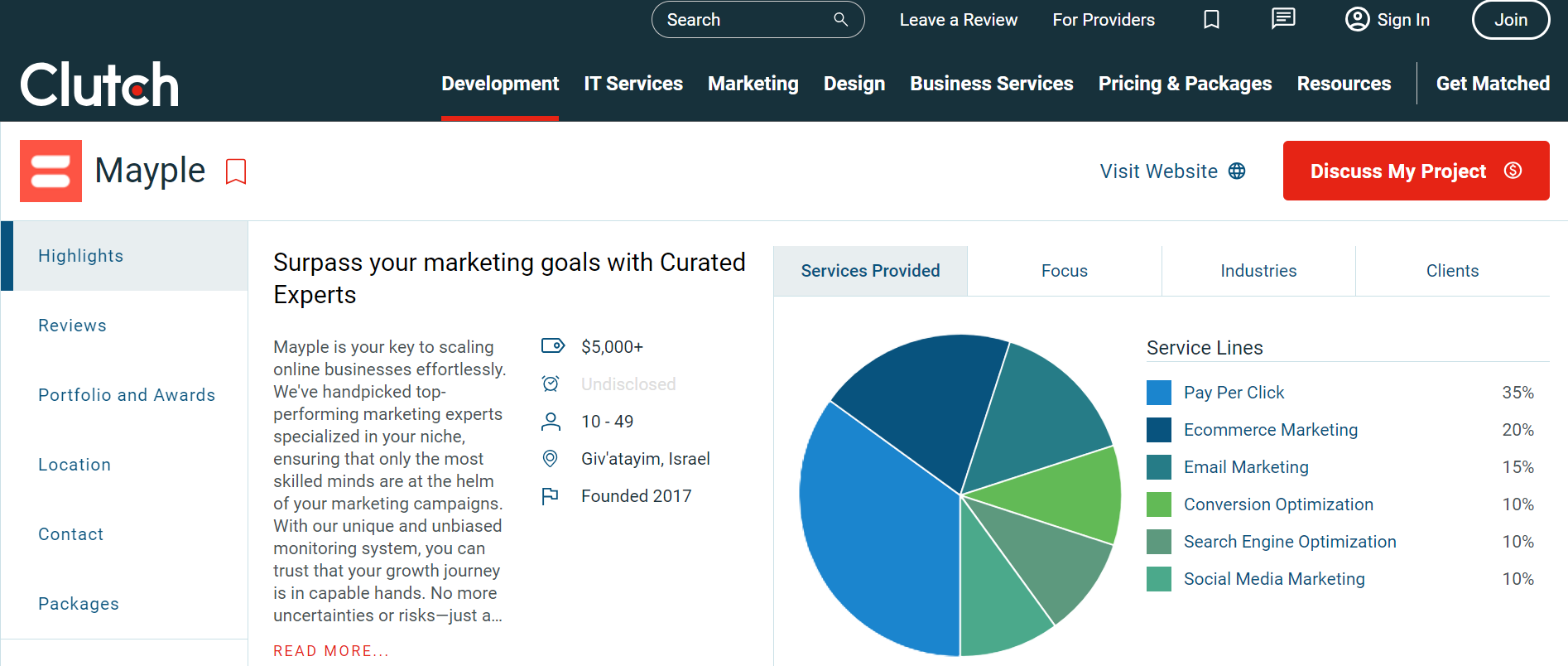
How to create effective listings
Optimizing profiles and building reviews are key to success on these platforms, but getting clients to leave reviews can be difficult.
It’s best to focus on one or two channels initially.
Steps to optimize your profile:
First, create a profile on directories or listings, and optimize it by:
- Using targeted keywords, professional visuals, and comprehensive service descriptions.
- Providing backlinks to your website (this is a valuable tactic to improve domain authority without heavy investment in SEO).
- Providing examples of your work or client success stories directly on your listings.
Next, request reviews from your clients, making it easy for them to leave feedback.
Timing is crucial—ask for reviews when clients are most satisfied with your service, such as right after a successful project launch or milestone.
Sending a thank-you email with a subtle request for a review can be effective. For example, you might send a personalized message like:
“We’ve really enjoyed working on [specific project] and would love to hear how it’s impacted your business.” Include a link to the review form in the email.
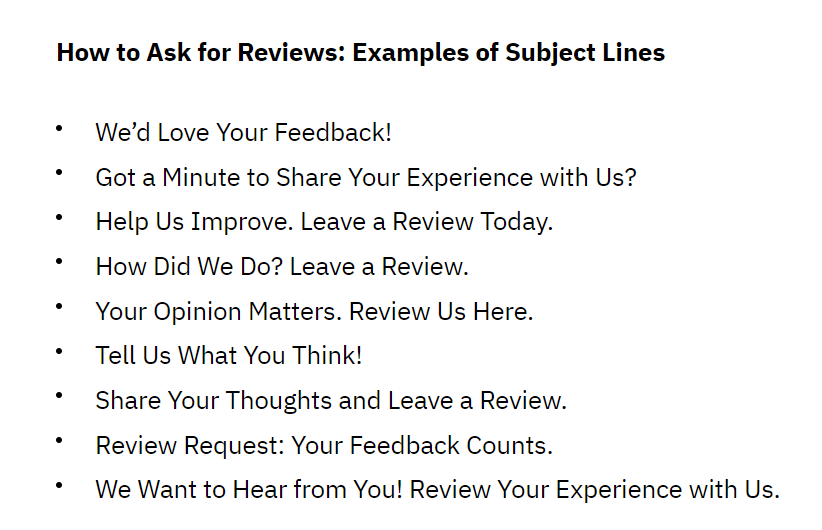
Source: InMoment
Tips:
- Offering an additional service, like a website audit or a brainstorming session, could sweeten the request.
- Providing a few points or a template to guide your client review can be helpful without being overly prescriptive. Something like “We worked with [agency name] on [project type], and they helped us achieve [specific result]. Their communication was excellent, and they delivered [specific service or outcome].”
- Services like GatherUp or Grade.us automate these review requests, making it convenient for both the agency and the client.
Reference resources:
#12. Build referral programs
While word-of-mouth can be hard to track and scale, referral programs provide a structured way to encourage and facilitate referrals from clients and partners.
Referral programs are affordable for agencies at all stages and tend to have high conversion rates.
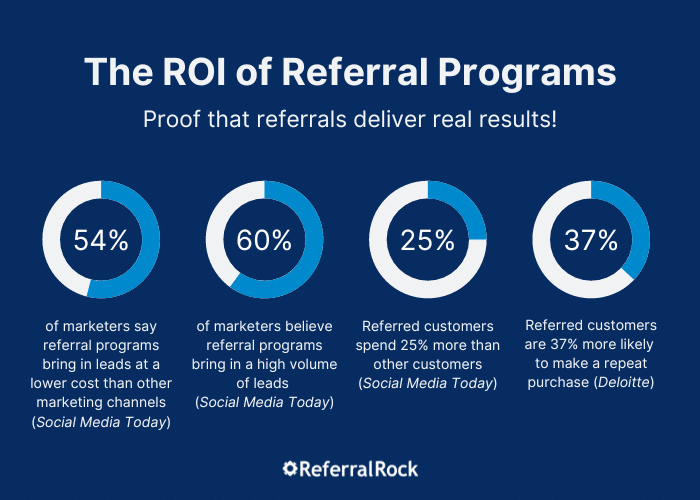
According to Referral Factory, businesses that implemented referral programs saw conversion rates for referred leads as high as 53%, significantly higher than leads from paid ads.
The challenge: Building a client base from scratch can be daunting, especially for small marketing agencies.
How to build a successful referral program
Step 1: Define the right incentives that align with your business model
These could be discounts on services, cash rewards, or value-added perks for both the referrer and the referred client.
Step 2. Use referral software
Managing referrals manually can be overwhelming as your agency grows.
Tools like Referral Rock or Referral Factory automate the process by generating unique referral links, tracking results, and distributing rewards.
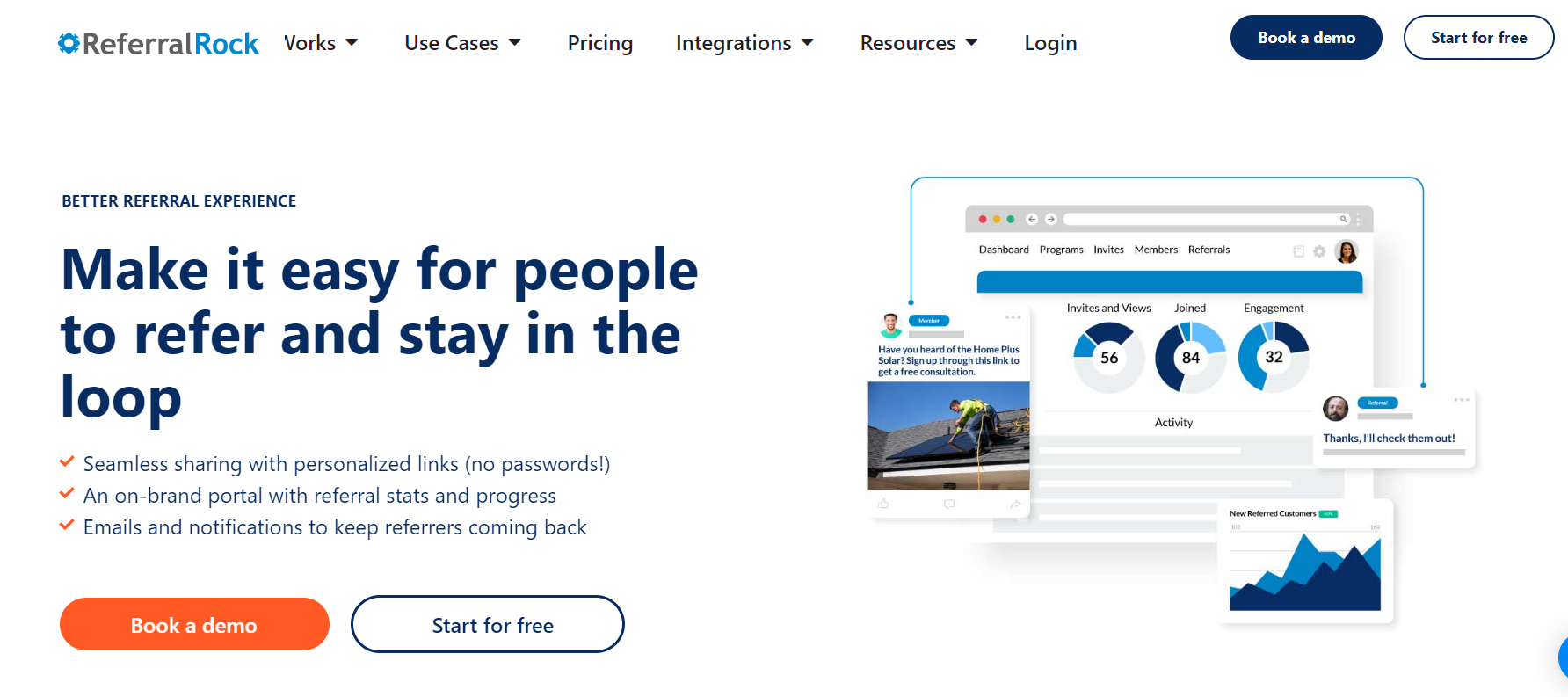
These platforms can also integrate with your CRM, making it easier to track participation and reward referrers.
Step 3. Launch and promote your program
Start by reaching out to your most loyal customers—they’ve already shown trust in your agency, making them ideal candidates to kickstart your referral program.
Personalized emails asking them to refer others can generate initial traction.
If you’re a new agency without an established client base, consider partnering with complementary businesses or influencers who serve your target audience.
For example, agencies have found success by teaming up with industry bloggers or service providers who refer clients in exchange for mutually beneficial incentives.
Next, promote your program to all clients. Use a combination of email marketing, social media, and even post-purchase pop-ups to inform clients about the referral program. Make the process simple and easy to follow.
For example, adding a referral link to every client interaction, such as invoices or newsletters, ensures it stays top-of-mind.
Remember to track key metrics like participation rates, referral volume, and conversion rates.
If certain parts of the program underperform, tweak your incentives or adjust how you promote it.
Reference resources:
- How To Build a Referral Program + Win More Customers
- How to Build a Referral Program in 2025 (With 80+ Examples)
#13. Guest blogging
You’ve likely heard plenty about the benefits of guest blogging.
It’s cost-effective, easy to scale, and provides immediate visibility and credibility.
When you contribute high-quality, valuable content to reputable blogs, you can also build valuable backlinks (especially Do-Follow links) for your agency’s website. This improves SEO, attracts targeted visitors, and generates leads.
Agencies like Mob.is.it and Siege Media have successfully used guest blogging to expand their reach and grow their client base.
However, landing guest blog opportunities can be challenging, especially for new agencies without a solid reputation or established networks. You need a thoughtful and strategic approach.
How to successfully guest blog
Step 1. Find the right blogs or websites for guest blogging
Here are some search strings you can use:
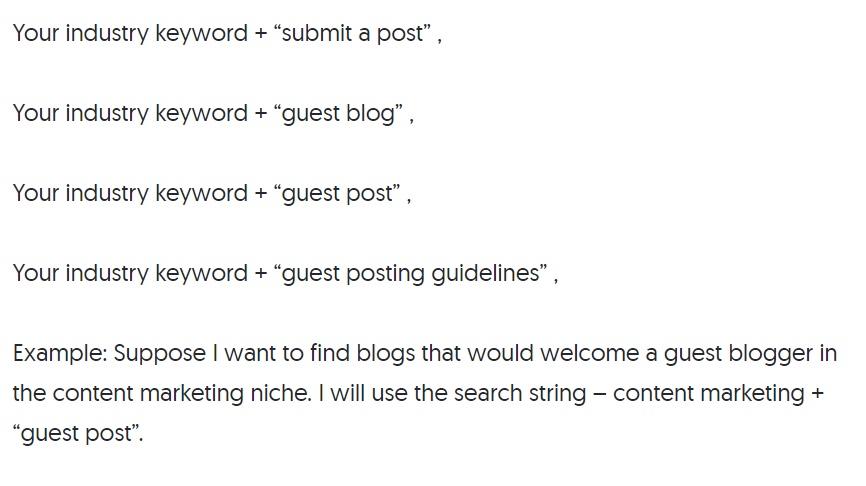
Source: Neil Patel
Be mindful of these factors:
- Is your target audience likely to visit this blog/website?
- Are they open to guest post pitches?
High-authority sites are more receptive to agencies with a guest blogging track record.
If you’re a new agency, start with smaller, niche blogs.
Once you’ve published a few pieces, use them as proof to pitch to larger publications.
Practical tactics to get more guest blogging opportunities:
Tactic 1. Search keywords that you think people would find your services valuable and review the top organic results. Look at the type of content and reach out to the publisher, offering to provide similar or complementary articles.
Tactic 2. Check the backlink profiles of high-ranking pages using tools like Ahrefs or Moz. Reach out to the sites linking to those pages and suggest content ideas where you could be included or contribute.

Source: Neil Patel
Tactic 3. Identify writers who regularly contribute to articles in your niche and follow them on social media, particularly Twitter. Engage with their work, and when you’re ready to pitch, this prior relationship will help you stand out.
Step 2. Reach out
For newer agencies, personalizing each pitch is crucial for increasing acceptance rates.
Research the blog’s audience and suggest article topics that fill content gaps or provide fresh insights. Highlight how your content would benefit their readers.
You can also engage with the blog’s community by commenting on posts or sharing their articles.
When pitching, emphasize how your content provides unique value and aligns with the blog’s focus. Always include client case studies or past work to establish credibility.
Tips:
- Always include your LinkedIn profile in your outreach emails to add credibility. It provides an easy way for editors or site owners to verify your professional background.
- Send follow-up emails regularly.
Step 3. Create content
Once your pitch is accepted, focus on writing detailed, high-quality content that remains relevant over time.
Evergreen articles—those offering long-term value—will continue driving traffic to your agency’s website long after they’re published.
Tip: Topics like industry best practices or comprehensive how-to guides will stay relevant for an extended period.
Reference resources:
- Guest Blogging for SEO: Everything You Need to Know
- Tips For Writing A Blog Post In Under 60 Minutes
- Guest Posting Opportunities: How to Find Them in 2025
#14. Become a partner of popular SaaS tools
That’s what Web Canopy Studio did and got a lot of valuable clients.
They’ve become a top-tier HubSpot Partner agency since 2014, which brought it direct referrals from the platform’s clients and positioned it as an expert in inbound marketing.
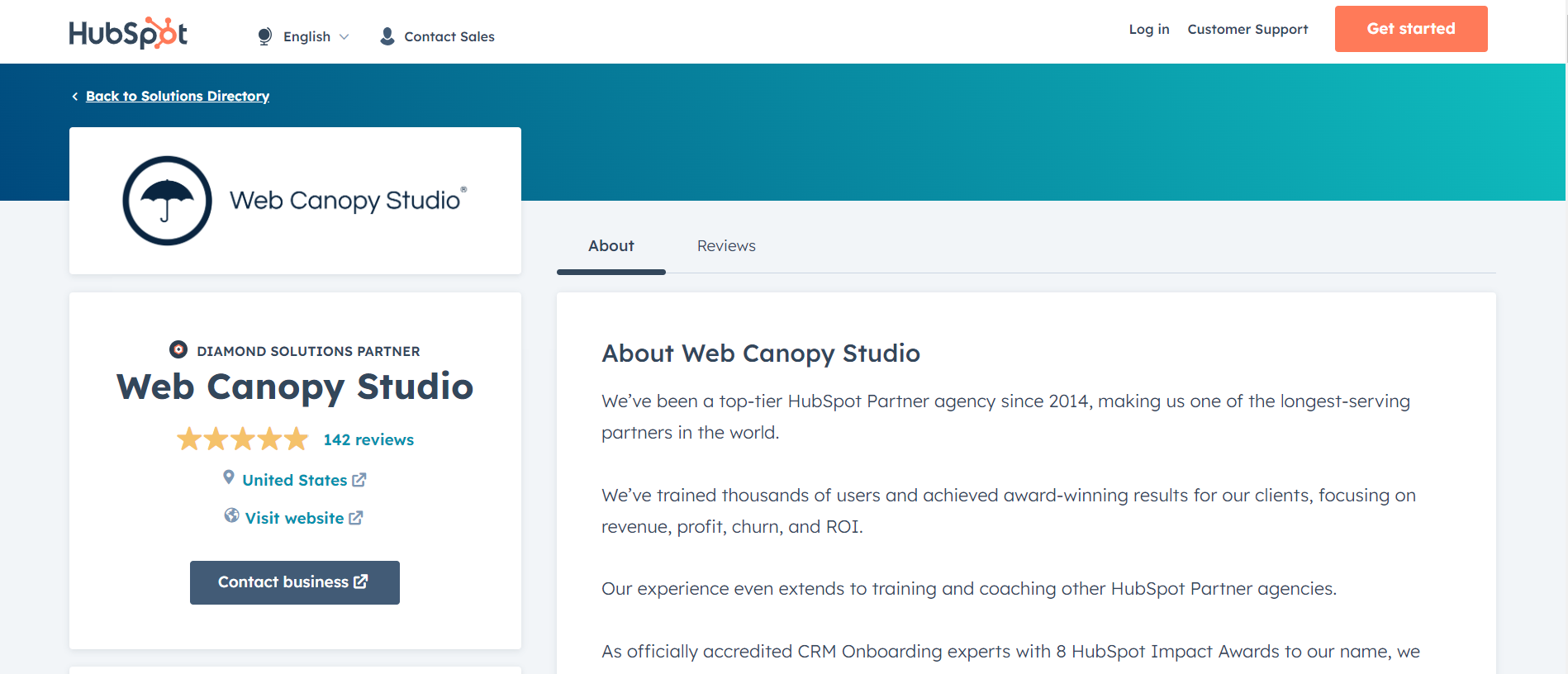
You can also partner with other popular SaaS tools like Shopify, WordPress, or Google Ads, depending on your agency’s niche and target audience.
How to become a partner of popular SaaS tools
Step 1. Find the Right SaaS Platform for Your Agency
To find the right SaaS tool, consider these three factors:
1) Does it align with your agency’s services and target clients?
Here are some examples:
- HubSpot for inbound marketing and CRM services
- Shopify for eCommerce services like store design, SEO, and digital marketing
- WordPress for web design and content marketing
- Google Ads for PPC services
2) Do you meet their partnership requirements?
Some quick research will help you figure this out.
Typically, most SaaS platforms require you to complete certifications, demonstrate your expertise, and meet certain sales or performance metrics.
3) Are their training programs free or paid? Do they match your budget?
Many platforms offer free or paid training programs. If you’re just starting, complete free training in core areas to get certified.
Step 2. Complete training and get certified.
This step takes time and effort—stay consistent!
Step 3. Do these once you qualify as a partner:
- Offer specialized services around the SaaS tool.
For example, if you partner with Shopify, offer store setup, SEO, and product marketing tailored to Shopify’s features.
- Optimize your listing in the partner directory.
Once you qualify as a partner, your agency will be listed in the platform’s directory. This is where potential clients find you.
Optimize your listing by including client testimonials, case studies, and a detailed description of your services.
For example, Salted Stone optimized their HubSpot directory profile to highlight their expertise in inbound marketing, which helped them secure more leads.
- Leverage co-marketing opportunities the SaaS platform gives you
Participate in joint webinars, case studies, or marketing campaigns that showcase your agency’s expertise to the platform’s user base.
Shopify, for example, often co-hosts webinars with their partners, which gives agencies massive exposure to new clients.
- Track performance and grow in the partnership program
Most SaaS tools offer tiered partnership levels (e.g., Silver, Gold, Diamond).
As you acquire more clients and demonstrate success, you can move up the ranks. This often comes with additional benefits, such as higher referral rates, priority listing in the directory, and co-branded marketing opportunities.
#15. Paid Ads
Paid ads are a versatile and effective strategy for client acquisition.
Unlike organic strategies like SEO, which take time to gain traction, paid ads allow businesses to reach potential clients almost instantly.
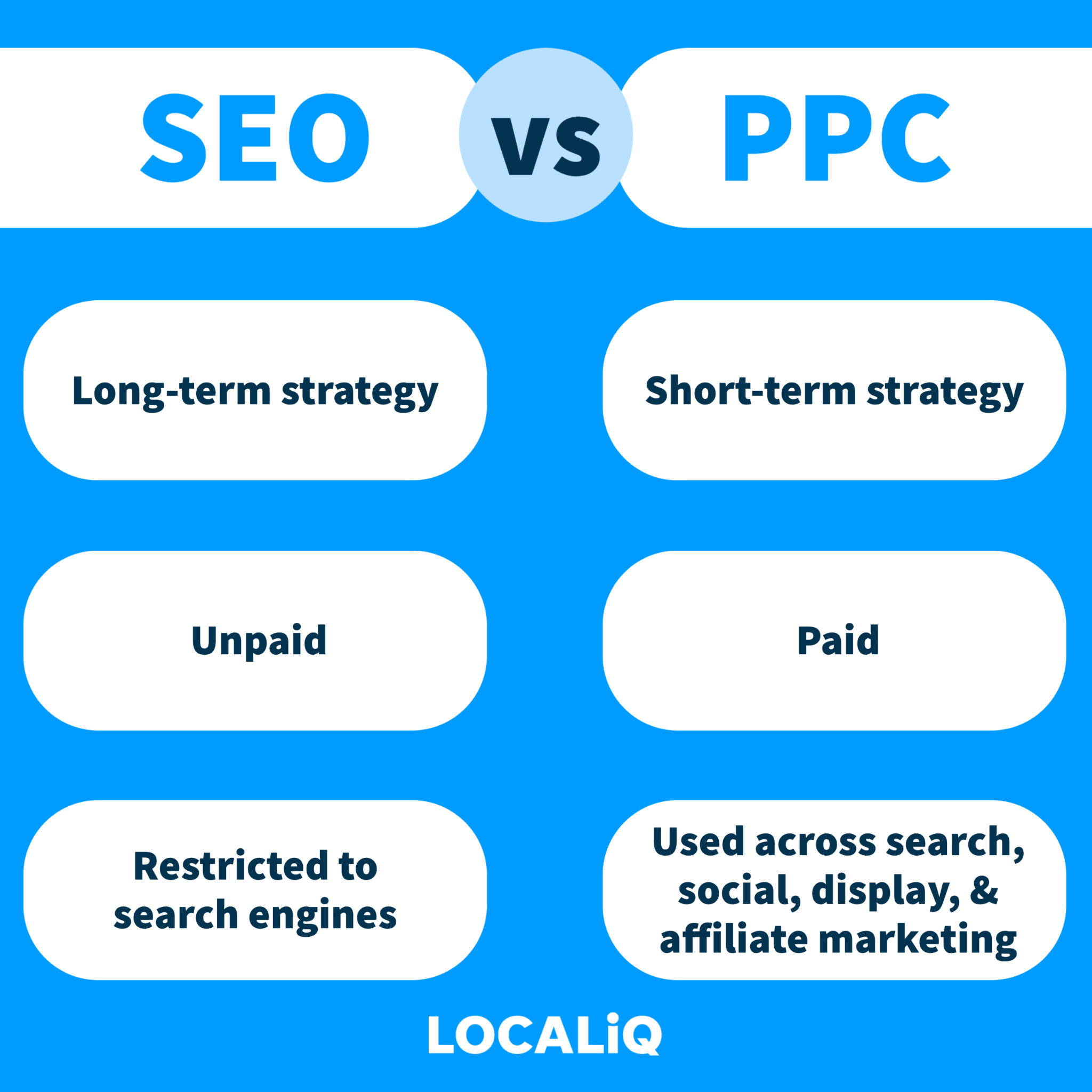
This is especially beneficial for agencies seeking quick client acquisition.
Additionally, paid ads are scalable and measurable.
Many small marketing agencies have successfully used paid ads to grow their client base.
For example, Inflow used Facebook Ads to generate high-quality leads and convert them into long-term clients.
How to use paid ads for client acquisition
Step 1. Understand your target audience
To be effective, you need to define your audience’s demographics, interests, and behaviors.
Start by reviewing your existing clients.
Use tools like Google Analytics or CRM data to identify customer demographics, engagement patterns, and top-converting channels.
Then, segment your audience into smaller groups for more tailored messaging.
Step 2. Choose the right platform
Select the platform where your audience spends the most time.
For B2B agencies, LinkedIn Ads might be most effective, while Facebook Ads or Instagram Ads may work better for agencies targeting consumers.
Google Ads is also ideal if you’re focusing on search intent (people actively searching for services like yours).
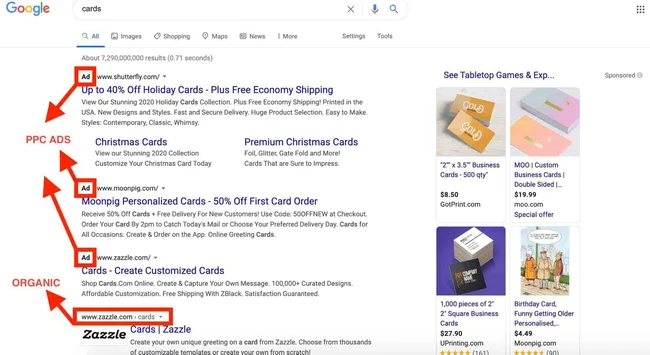
Step 3. Set a realistic budget
One of the biggest challenges with paid ads is balancing ad spend with ROI.
You need to set a realistic budget to avoid overspending without generating enough leads.
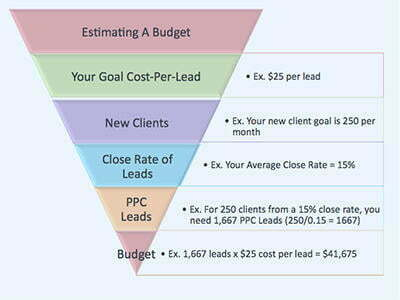
Image source: Word Stream
For smaller agencies with limited budgets, start small—many agencies begin with daily budgets as low as $5-$10 per day.
Focus on optimizing these small campaigns before scaling. Testing ads and audience targeting in smaller increments helps avoid wasting your budget.
Step 4. Create compelling Ad copy and visuals
Your ad copy and visuals should directly address the pain points of your target audience.
Successful agencies like Inflow highlight their unique value proposition and the specific problems they solve for their clients.
Use A/B testing to refine your headlines, calls-to-action, and images to see what resonates best.
Step 5. Optimize landing pages for conversion
Even the best ad will fail if it drives traffic to a poorly optimized landing page.
So, ensure your landing pages have clear messaging, strong calls-to-action, and fast load times.
Test different layouts to see which designs lead to more conversions, and implement Google Analytics, Facebook Pixel, or HubSpot to monitor bounce rates and conversion metrics.
Step 6. Choose the right keyword
In competitive industries like SEO services or PPC management, the cost of paid ads, particularly on platforms like Google Ads or Facebook Ads, can skyrocket due to high bidding for popular keywords.
To overcome this, focus on niche keywords or long-tail keywords, which are less expensive but highly relevant to specific audiences.
Tips:
- Algorithms change frequently. Stay updated on industry news to adjust your ad strategies quickly in response to algorithm shifts.
- Regularly refresh your ad creatives—introduce new visuals, tweak messaging, or adjust targeting to avoid ad fatigue.
- Use retargeting ads to bring back potential clients who showed interest but didn’t take action. (See Strategy #16.)
- Track performance metrics like click-through rates, conversion rates, and ROI to optimize your campaigns.
Other resources:
- Google Ads Benchmarks for YOUR Industry [Updated!]
- Paid Media Marketing In 2025: 7 Changes Marketers Should Make
- 13 Paid Media Trends To Watch Out For [Updated for 2025]
- How To Create Facebook Lead Ads That Convert
- The Ultimate Guide to Advertising in 2025
#16. Client Retargeting Campaigns
Retargeting is proven to increase conversions by focusing on a highly engaged audience—those who have already interacted with your website or content.
Here’s how it works:
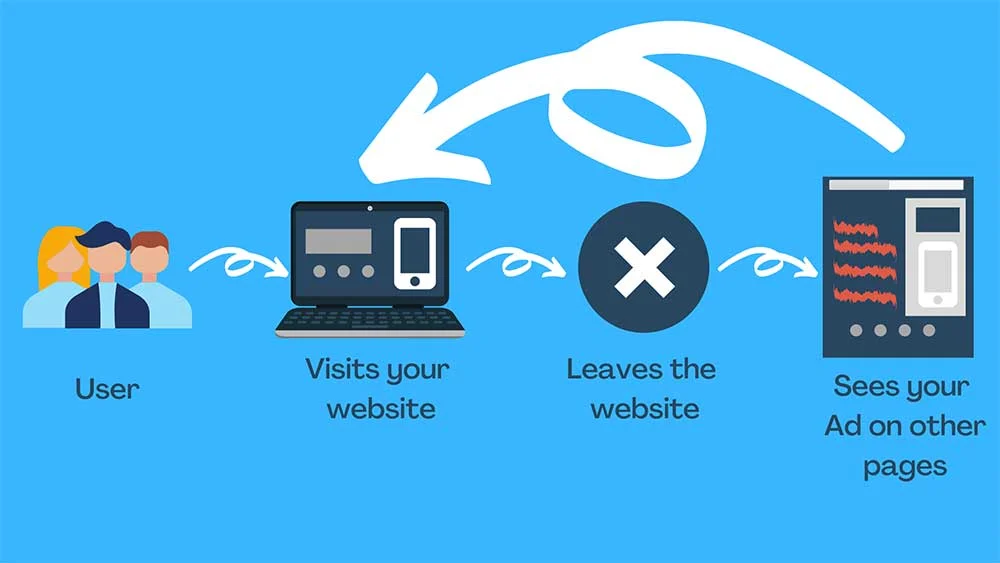
Image source: Mo Agency
Studies show that retargeting ads are 10x more likely to generate clicks and conversions than typical display ads, especially when the messaging is personalized to the user’s behavior.
Small marketing agencies like Myfix Cycles saw a return on ad spend (ROAS) of $15 for every $1 spent after using Facebook retargeting, demonstrating the power of retargeting even with limited budgets.

Image source: Webrunner Media
How to implement a retargeting strategy
Step 1. Place tracking pixels (like the Facebook Pixel or Google Tag) on your website
These pixels allow you to track visitors and create custom audience segments based on their behavior—whether they visited a specific service page, started filling out a form, or viewed a blog post.
Step 2. Segment your audience based on their actions
Segmenting your audience helps maximize the effectiveness of your retargeting campaigns.
You can can create different ad campaigns for:
- Visitors who spent time on your service pages but didn’t inquire.
- Those who visited a case study page but didn’t convert.
- Users who abandoned a booking form or consultation request.
This provides personalized messaging that speaks directly to where they are in the buyer’s journey.
Step 3. Create engaging ad copy and visuals
Your retargeting ads should address the specific action (or inaction) your visitor took.
If someone viewed your SEO service page, show them an ad that highlights your agency’s SEO success stories or offers a free consultation.
Keep the ad creative concise, visually engaging, and action-oriented to drive conversions
Step 4. Retarget across multiple platforms
While platforms like Facebook and Google are the most popular for retargeting, consider extending your efforts across other platforms like LinkedIn for B2B clients or Instagram for a broader consumer audience.
This multi-channel approach ensures you stay visible wherever your target audience spends their time online.
Tips:
- Optimize your campaigns with A/B testing
- Exclude converted users to save ad spend and improve user experience by preventing ad fatigue. However, you can continue to engage them through upselling or cross-selling ads for additional services.
Reference resources:
- The Complete Guide to Facebook Retargeting
- How to Set Up a Remarketing Campaign in Google Ads
- What is Retargeting? Everything You Need to Achieve Greater ROI
- 9 Best Practices for LinkedIn Retargeting That Cut Costs & Drive Conversions
- 8 Advanced Retargeting Tactics for Boosting Your Return on Ad Spend
#17. Networking
Many marketing agencies find that networking brings valuable clients and major deals.
For example, Shahed Islam, owner of a 19-year-old agency generating nearly $5 million annually, says, “90% of valuable clients come through networking.”
When you build genuine connections, people remember you when they—or someone in their network—need your services.
A strong network in industry circles gives your agency more exposure, builds trust, and helps establish you as a niche expert. This opens doors to new clients, partnerships, and learning opportunities.
However, networking isn’t easy for everyone. Some agencies struggle due to two main reasons:
- Lack of Patience
Successful networking takes months and requires consistent effort before you start seeing results. It’s not a quick fix or something that can be automated. - Wrong Approach
Many people network to get immediate work, but this rarely succeeds. Effective networking is about building meaningful relationships first, not landing clients right away.
How to Build a Strong Network
Step 1: Identify Your Target Audience and Goals
If you want to expand your client base, research your target clients, including their characteristics and location.
Knowing where your ideal clients spend their time helps you decide which events and platforms to attend.
- Client Characteristics: Helps identify where your audience gathers. For example, a marketing agency focused on small businesses should attend events tailored to small business owners rather than corporate enterprise events.
- Client Geography: If you serve local clients, in-person networking at local events is more effective. For international clients, focus on online networking platforms.
Step 2: Find the Right Networking Events and Platforms
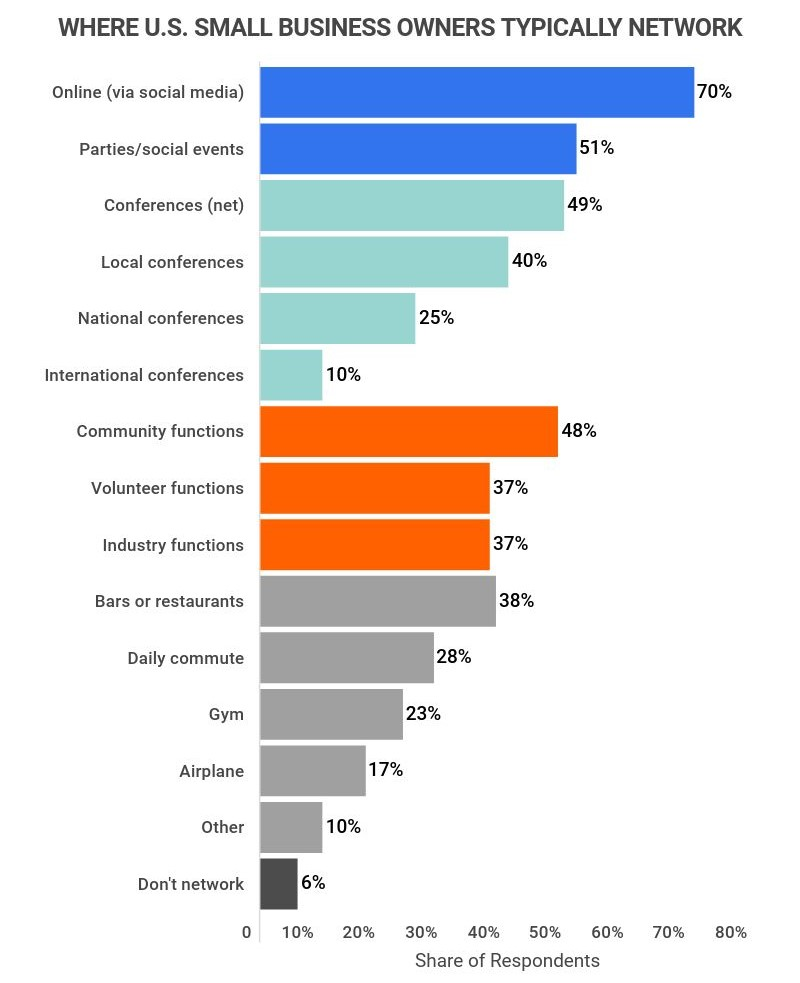
Image source: Zippia
Attending the right events ensures you meet people relevant to your field and more likely to engage with your services.
- Online Networking: Platforms like LinkedIn, Twitter, Slack communities, Reddit, Indie Hackers, and specialized Facebook groups are great for connecting with industry professionals.
- Offline Networking: Join relevant business associations, attend industry events, conferences, and participate in local meetups.
Tip: Use platforms like Eventbrite or Meetup to find industry-specific events.
Step 3: Reach Out and Build Connections
Don’t be afraid to cold-connect, especially on platforms like LinkedIn.
Personalize your outreach by sending connection requests with a brief note to people you admire or those within your target market.
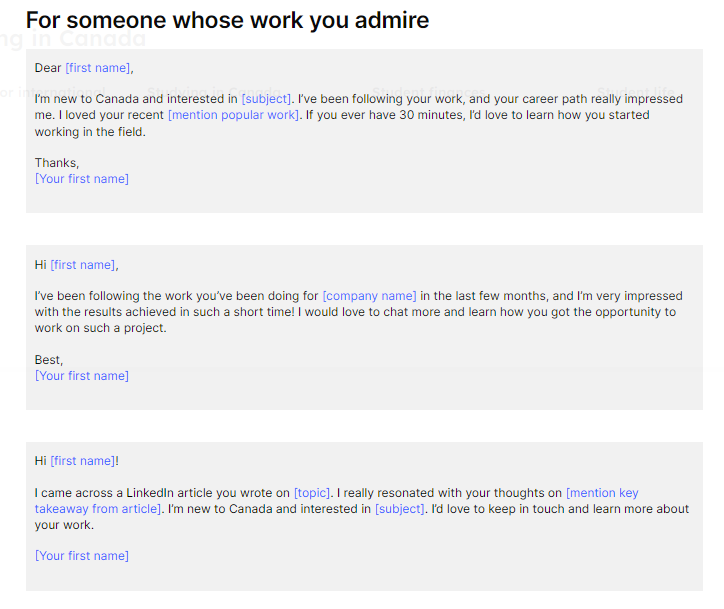
Source: Arrivein
A simple introduction paired with a compliment or thoughtful comment can lead to meaningful conversations.
Contributing to relevant online communities is also a great way to network.
Engage in discussions, answer questions, and offer helpful advice. Establishing yourself as an expert will naturally attract potential clients.
Pro Tip: Before attending events, learn about local customs and be culturally aware in your conversations. Focus on asking questions about others’ businesses to create natural, engaging dialogue.
Step 4: Maintain Meaningful Connections
Don’t let a connection go cold. Make it a habit to regularly engage with your network.
After meeting someone at an event, follow up with a message to thank them for their time and continue to nurture the relationship.
Frequent interactions, such as commenting on posts or sharing insightful thoughts, help keep the connection alive.
Key Tips:
- Be Genuine: Focus on building trust and rapport rather than just collecting contacts. Show genuine interest in others’ work and how you can provide value.
- Consistency is Key: Consistent engagement—whether online or offline—keeps you top of mind when opportunities arise.
- Value Quality Over Quantity: A handful of meaningful connections are far more valuable than hundreds of superficial ones.
Other resources:
- Strategic Networking Tips For Faster Business Development
- How to Network Effectively: 15 Tips You Can Start Using Today
- How to Network on LinkedIn Like a Pro
- Networking can be awkward. Here’s how to make it work for you
III. Which client acquisition strategy is right for your marketing agency?
We can’t decide which strategy is right for you. In fact, nobody can, but you.
You know your agency best, so it’s up to you to determine the best client acquisition strategy to grow your business.
But don’t worry! Matthew Gallagher, founder at JBP.fyi, shared on Reddit a helpful tip to make this decision easier. According to him, there are four important factors to consider:
- Cost – The amount of money it takes to start.
- Technical Level – The amount of technical learning required to get started.
- Time – How long it takes to see success.
- Reputation Risk – The potential impact on your reputation.
Consider these factors, then choose two client acquisition strategies to test.
Learn from different sources and implement a lightweight version for 90 days. Get feedback from experts if possible.
Afterward, set up systems to automate the process, saving you time. Move on to the next two strategies for another 90 days; rinse and repeat.
Matthew also recommends agency owners track success by asking new clients how they heard about you or using UTM codes for web traffic.
Finally, review the entire process after a year. Look back at which client acquisition strategies gave you the greatest results and which ones were less effective.
Also, reflect on which strategies you enjoyed the most. Based on this, invest more in the ones that worked best.
IV. More Advice:
As you acquire more clients, new challenges will arise. Two common ones are:
- Handling bad clients, and
- Managing multiple clients at once.
Let’s delve into the solution for each.
How to deal with bad clients
With challenge No.1, the key is identifying and disqualifying them as quickly as possible.
This prevents you from wasting time and helps you avoid costly mistakes—both financially and emotionally.
Now, “how to identify a bad client?” – you might ask.
It’s best to set clear criteria for the work you do and the people you want to work with.
First, offer a transparent pricing model. Let them know what services you provide, what each service entails, and the costs.
This helps clients determine whether they can afford your services and when they’re looking to move forward before they contact you.
Second, make a list of your disqualifying questions to ask during calls.
It may take some time to develop your “no-fly list” of people, brands, and industries you prefer not to work with, but it’s worth it!
How to work well with multiple clients at a time
Once you have three or more clients, it becomes difficult to manage everything on your own.
There’s a significant amount of administrative work, such as signing contracts and updating clients on project progress.
At this point, it’s time to build a team and learn to put systems in place.
- Create templated documents (contracts, reports, invoices) that you can send to clients quickly when needed.
- Consider using an all-in-one project management platform to manage all aspects of your work, track team performance, and collaborate with clients. As your agency grows, your team won’t have time to switch between platforms.
With Upbase, you can significantly reduce the time spent on project management, teamwork, and client collaboration.
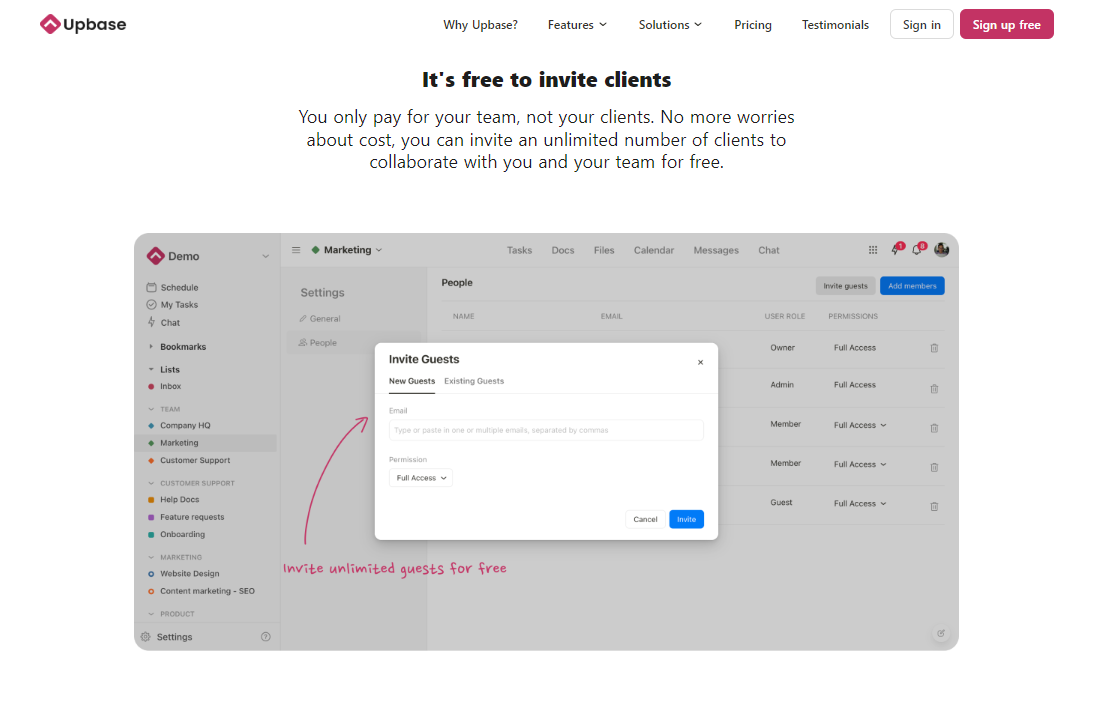
Many of our customers are small marketing agencies, and their feedback shows that the all-in-one design of Upbase helps them improve workflows and make their clients happier.
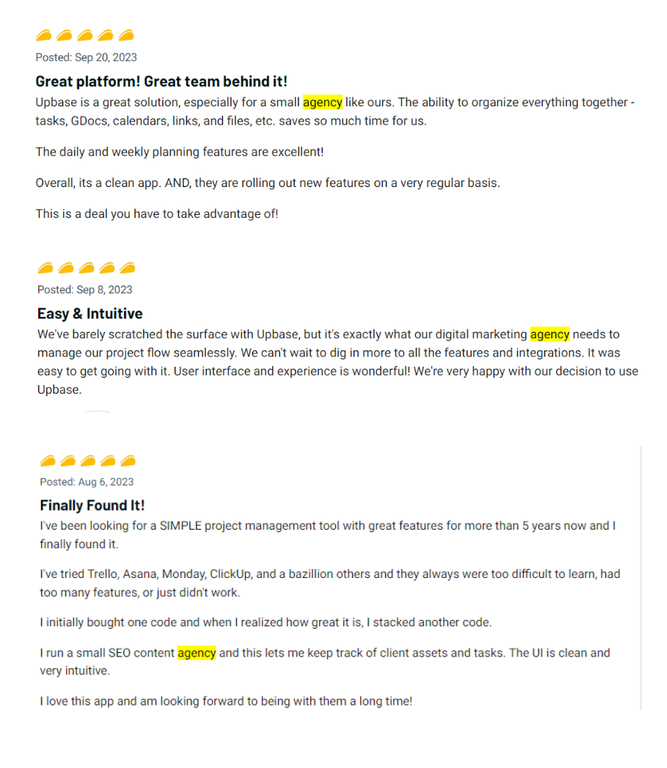
Some notable strengths that make Upbase a great choice for agencies include:
- Simple and intuitive UI — making it easier to onboard clients.
- Comprehensive features — including task management, team collaboration, calendar integration, and data management.
- Integrated chat function — allowing quick discussions and keeping team members and clients updated on project progress.
On top of that, Upbase offers a generous free version with unlimited tasks, members, and storage, along with a budget-friendly premium version that includes unlimited free clients.
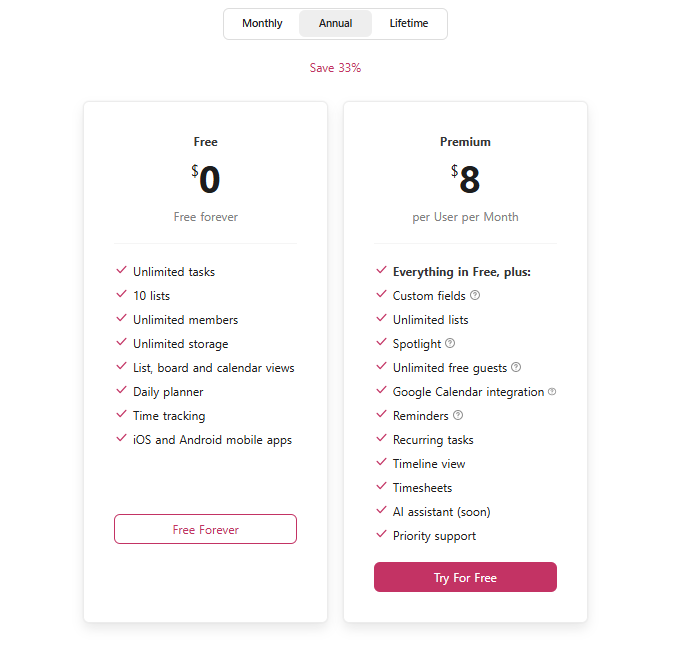
Sign up for a free Upbase account and set up your projects in minutes.
V. Wrap Up
Getting the first client is always the hardest.
Getting more clients afterwards is the second hardest.
We hope our list of 15+ proven client acquisition strategies helps you. All of them can work with the right fit, enough knowledge, and consistent execution.
Remember, just because a strategy works for some agencies doesn’t mean it will work for you, and vice versa.
Consider your resources, target clients, skill set, product pricing, and positioning when choosing the strategies that best fit your business.
Also, keep in mind that client acquisition strategies that work now may not always work in the future. The market changes, and you can’t control that.
Always be experimenting, learning, and adjusting your approach.
VI. FAQs
How to acquire clients for a marketing agency?
To acquire clients, focus on building a strong portfolio, showcasing past work, and offering clear value.
Some effective client acquisition strategies include networking, content marketing, running targeted ads, and personalized outreach.
Do emails actually work for client acquisition?
Yes, emails can be very effective for client acquisition when done right.
A well-crafted email that addresses the recipient’s specific needs, explains how your services can help, and includes a clear call to action can lead to conversations and new clients.
Cold calling vs. content marketing: which is more effective?
It depends on your goals. Cold calling can yield quick wins but often feels intrusive and has a lower success rate. Content marketing is generally more effective for long-term client acquisition and relationship-building.
